After a disappointing performance last season that witnessed a failure to qualify for the UEFA Champions League, Liverpool made a magnificent start to the 2023/24 English Premier League season, winning five of their first six games. A significant part of that success is due to the great variation they’ve demonstrated in their rest defence shape and the brilliant adaptability on show in every game.
Our tactical analysis and scout report will provide an analysis of how Liverpool‘s rest defence tactics have led them to better control of the game and announce themselves as title contenders this season. Let’s start with their build-up phase.
During the build-up
Firstly, in Liverpool versus Bournemouth, The home side used the rest defence shape of 3-2, with Virgil Van Dijk, Ibrahima Konaté, and Andrew Robertson forming the base. At the same time, Trent Alexander-Arnold and Alexis Mac Allister were positioned just ahead of them.
As you can see below, both Konaté and Robertson have to be positioned widely, with Van Dijk being slightly on the left, creating a gap between the Dutch and the French centre-backs.
It is worth mentioning that Konaté and Robertson have to stay wide to make it harder on the opposition’s forwards to press the Reds build-up. Alisson Becker could occupy this space to form a back four or Alexander-Arnold, as we are going to discuss later.
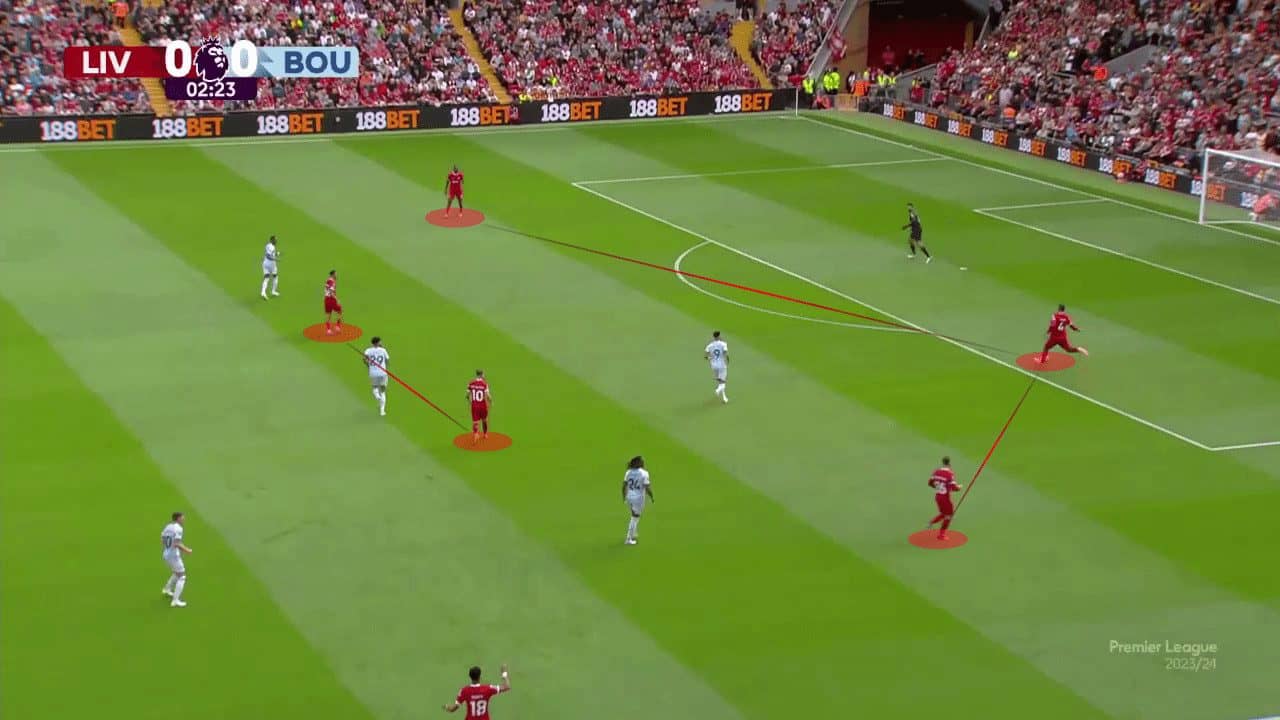
From almost their first build-up situation against the Cherries, Alexander-Arnold loses the ball, and Philip Billing immediately plays the ball towards Dominic Solanke, who is utilising the space between Van Dijk and Konaté, so Robertson had to run backwards to cover the centre and leave a space for Bournemouth right winger Antoine Semenyo to run unmarked.
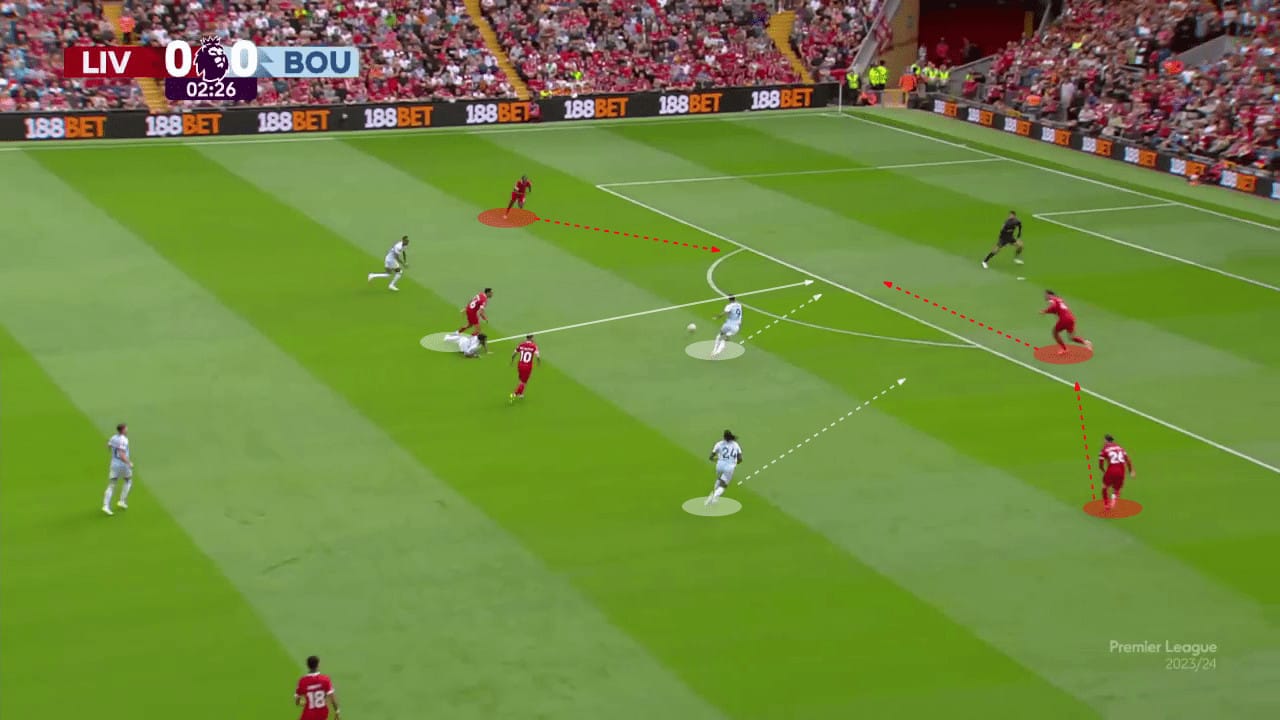
Both Van Dijk and Robertson covered the centre, but Semenyo had the space coming from behind and scored the opener for the visitors.
Therefore, the problems they faced with the 3-2 shape were primarily the space afforded between Van Dijk and Konaté as well as the space left for the opposition’s right-sided forward.
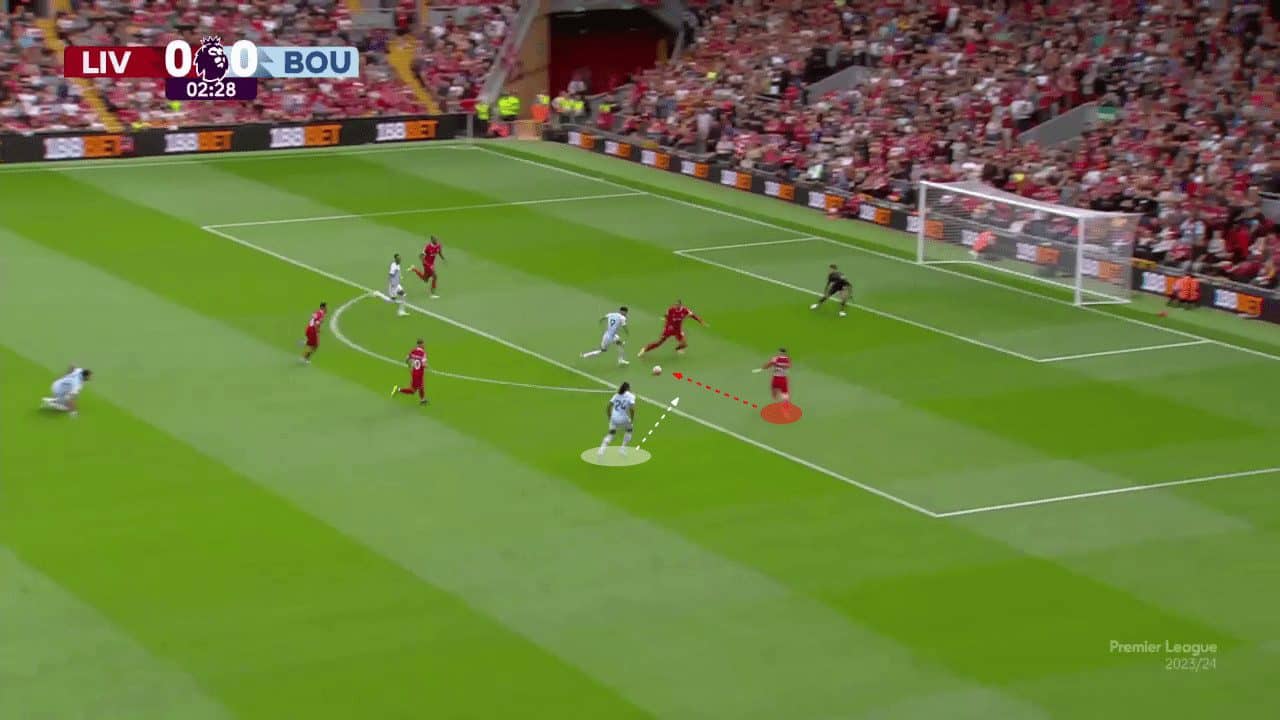
Moving on to the Newcastle United game.
At St. James’ Park, Jürgen Klopp’s side maintained the 3-2 shape, with Alisson joining the first line to help in the build-up to get the shape into more of a 4-2.
Arnold was shown to drop into the same area to escape the pressing of Anthony Gordon.
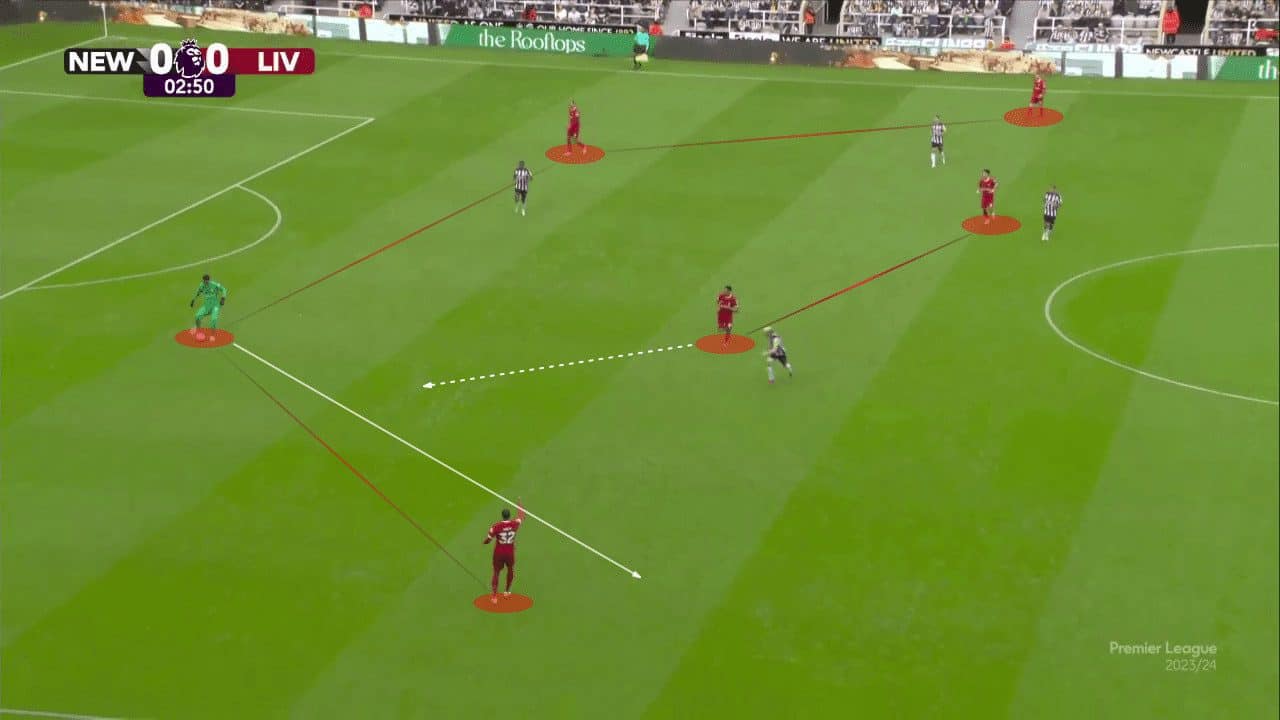
After that movement from Alexander-Arnold, the shape is a 4-1 shape, and the issue here was that Wataru Endō, who started the game, was left alone in a massive space in the centre of the field.
Additionally, Gordon’s pressing blocked the passing lane towards Alexander-Arnold, so Joël Matip was forced to keep progressing with the ball, and then his pass was intercepted.
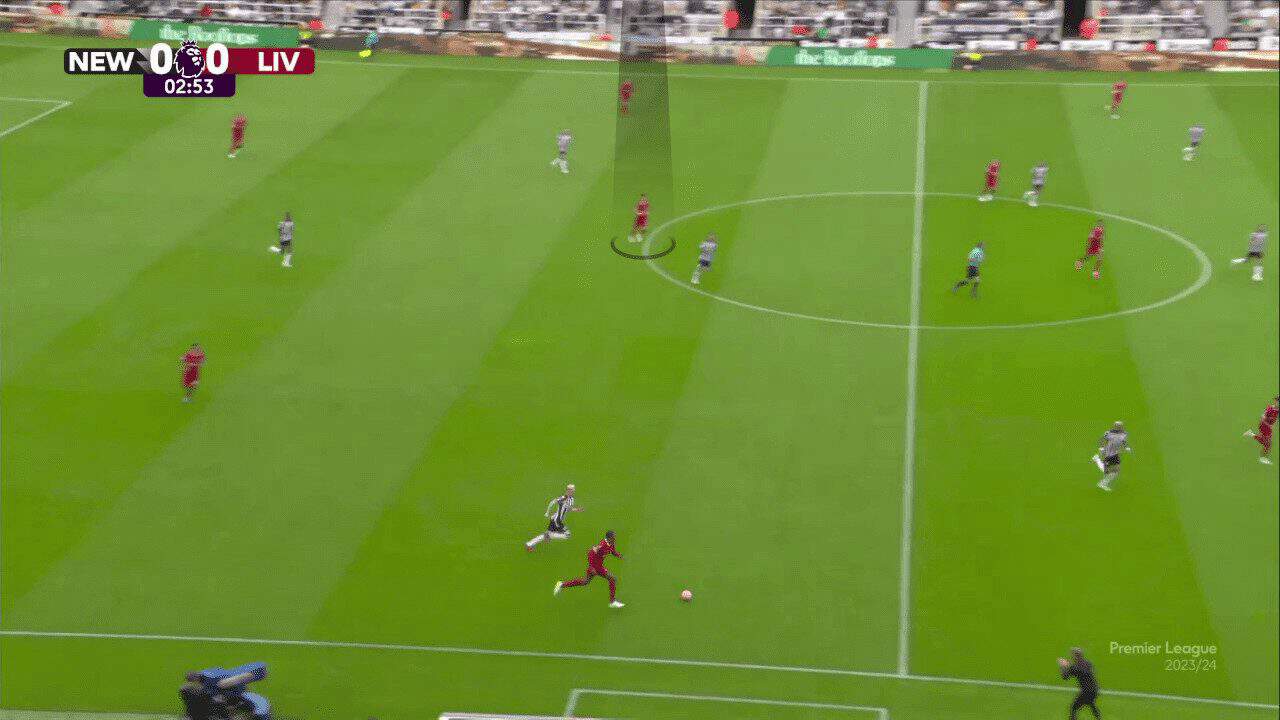
In the sixth minute of the game, Alexander-Arnold received a yellow card, and then a minute later, he made a foul on Gordon, which means he could have been sent off just after seven minutes from the kick-off, which was a transitional moment of the game.
After that, the German coach changed the build-up and rest defence structure to a 4-2 shape, with Alexander-Arnold staying wide and Szoboszlai joining Endō to form the double pivot in the midfield.
This change was intended to drag Alexander-Arnold from the central area, where he is at a greater risk of losing the ball for an attacking transition or committing a foul and getting a second yellow card early in the game.
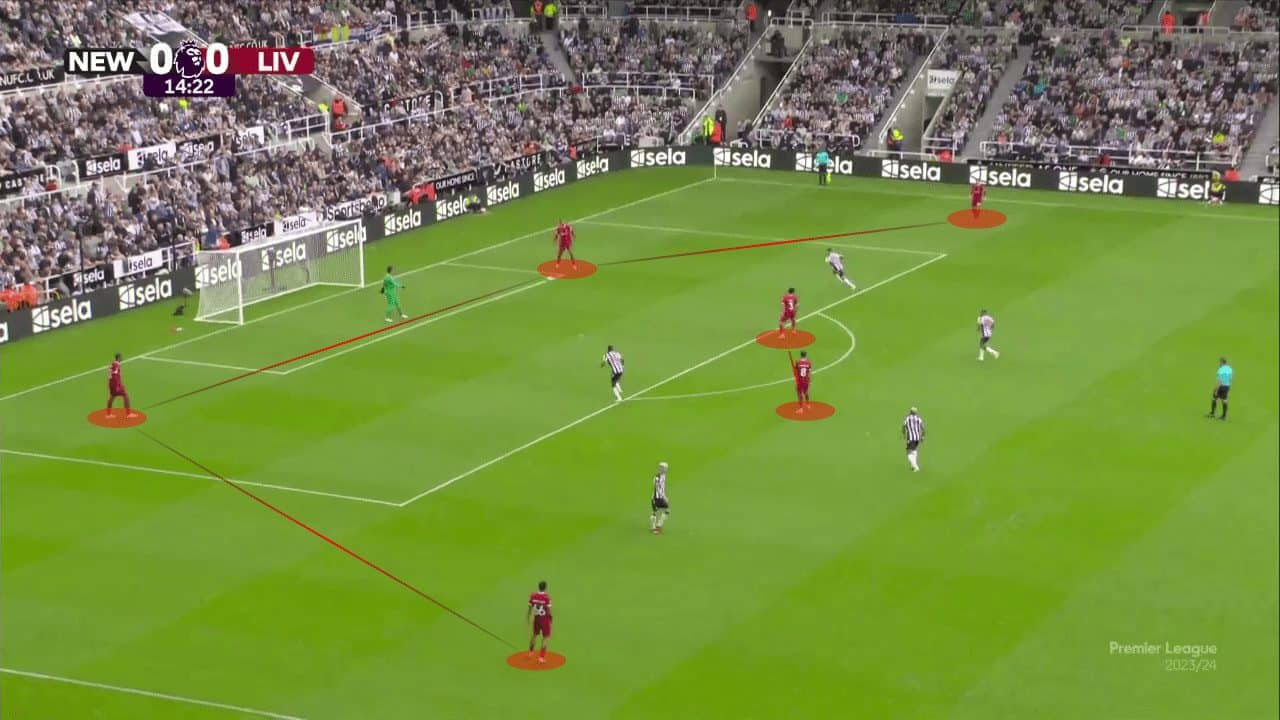
Typically, the same shape of the 4-2 with Szoboszlai is in the rest defence second line instead of Alexander-Arnold, who is positioned on the right side.
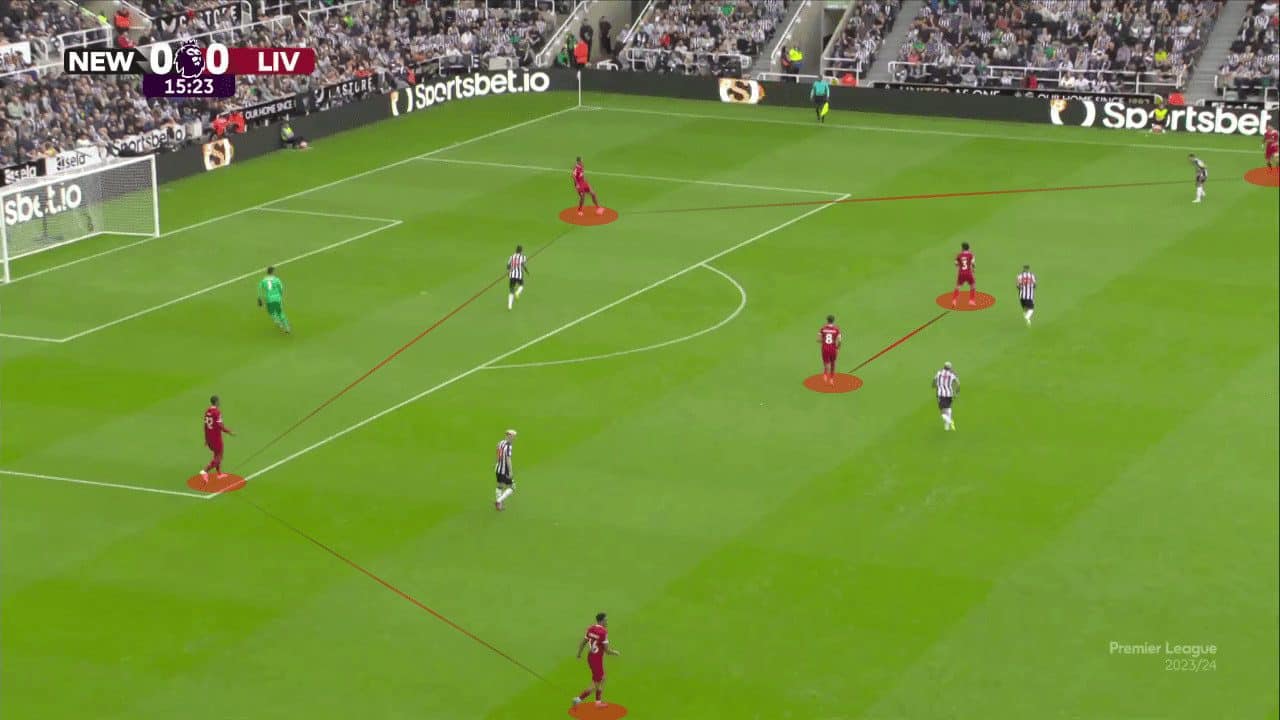
Arnold now is in the advanced position of Liverpool’s box-midfield with Szoboszlai at the base of it. Now Alexander-Arnold doesn’t have to risk the ball or make a tactical foul, as there is enough coverage behind him.
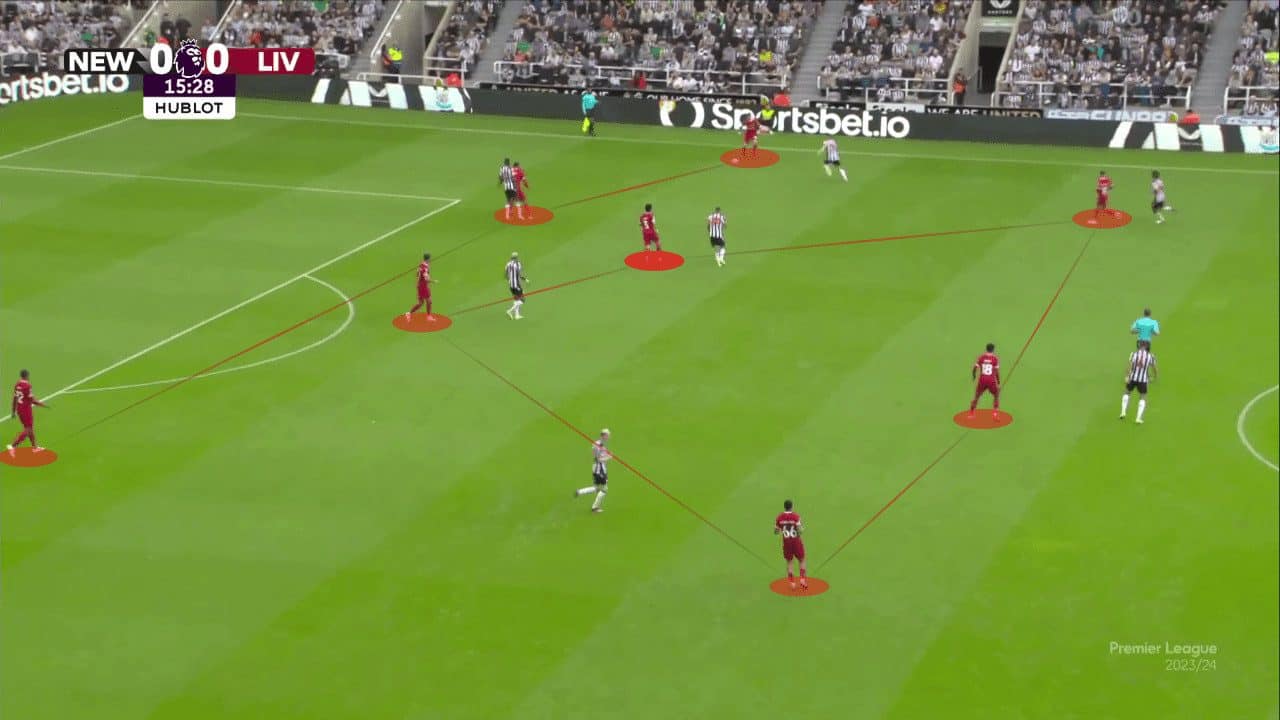
Unfortunately for Liverpool, Alexander-Arnold’s yellow card was not the only transitional moment in the game, but towards the middle of the first half, Virgil Van Dijk got a straight red card after his challenge on Alexander Isak.
Now Liverpool is one goal behind with only ten men and more than one hour to play, so how are they going to compensate for that?
Klopp’s side had their priority to maintain their 3-2 rest defence shape with Alexander-Arnold the (shadowed) staying wide and one of Szoboszlai and Mac Allister joining Endō in the midfield.
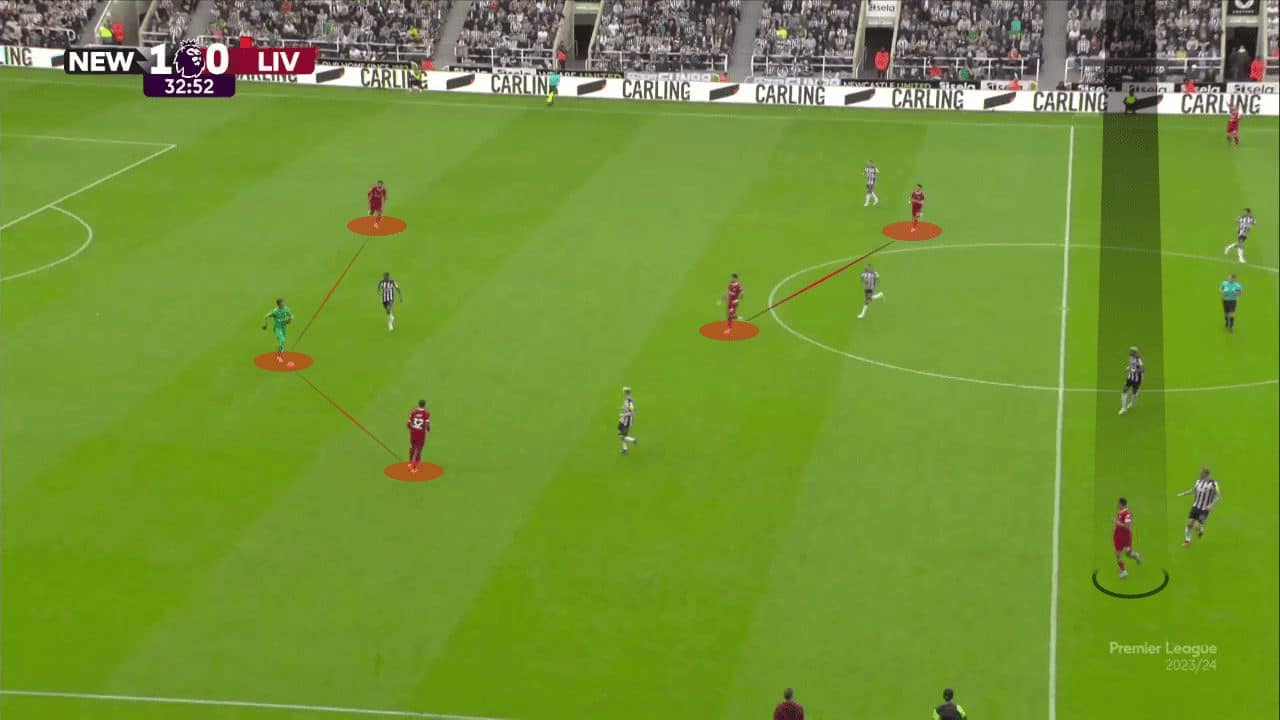
The most important thing they considered was to have two midfielders in the centre. Usually, Alexis Mac Allister was the one who joined Endō.
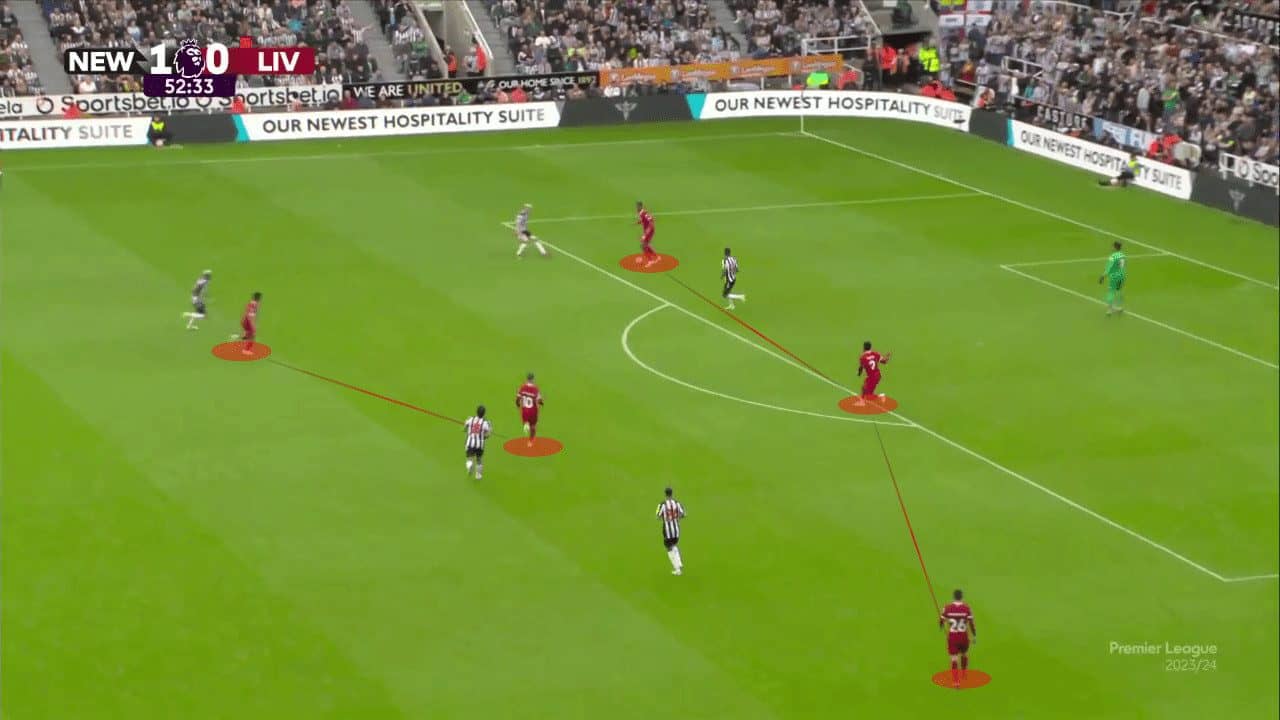
As we can see, they kept switching between the 3-2 and 4-2 shapes with the possible participation of one of the full-backs in the advanced position, so at least they have their standard 3-2 shape.
As Harvey Elliot replaced Endō, both Szoboszlai and Mac Allister formed the double pivot.
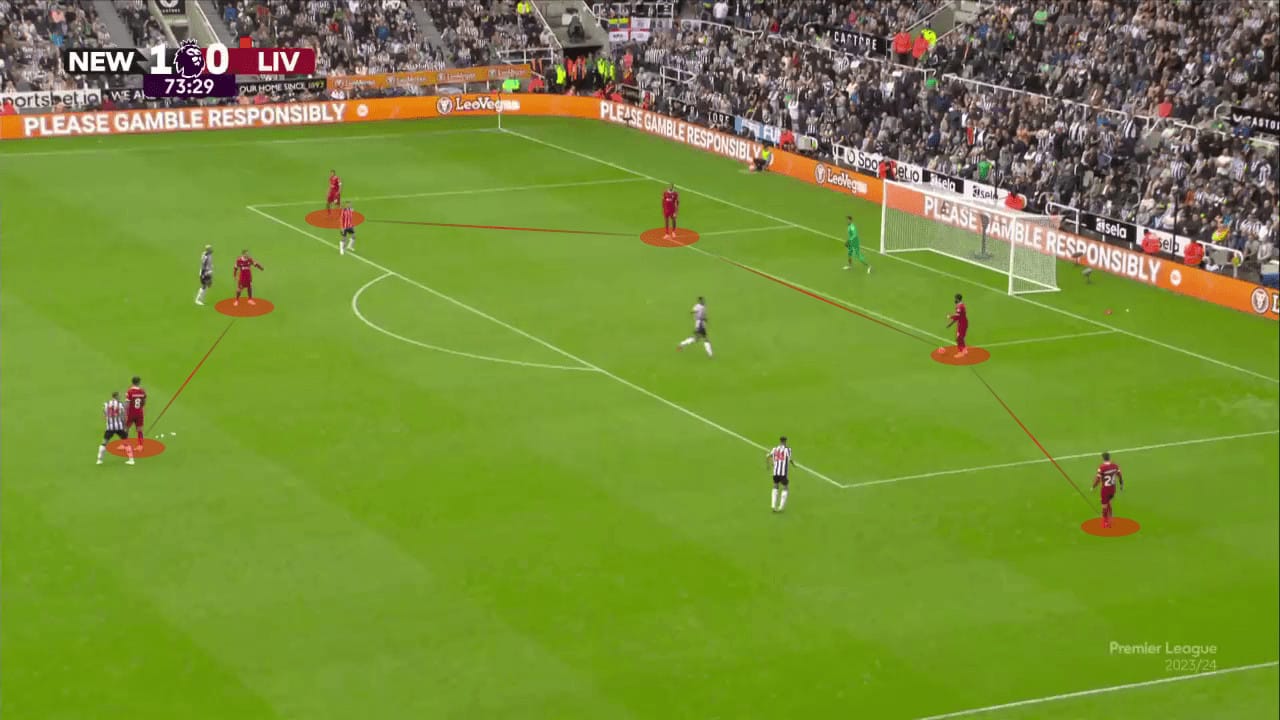
Jürgen Klopp had an impressive way of dealing with the red card against a top team like Newcastle, managed by Eddie Howe. Indeed, they couldn’t completely stop the Magpies’ counterattacks, but they minimised them considerably, waiting for Darwin Núñez to score two late goals and give Liverpool a massive away win.
After that special win at St. James’ Park, Liverpool hosted Unai Emery’s Aston Villa in the fourth game week of the English Premier League without the suspended Virgil Van Dijk. Did they continue with their 3-2 shape?
The answer is no. Instead, they carried on with the 4-2 shape they had after Alexander-Arnold’s yellow card in the last game.
A back four line of Robertson, Joe Gomez, Matip and Alexander-Arnold and ahead of them the pivot of Szoboszlai and Mac Allister.
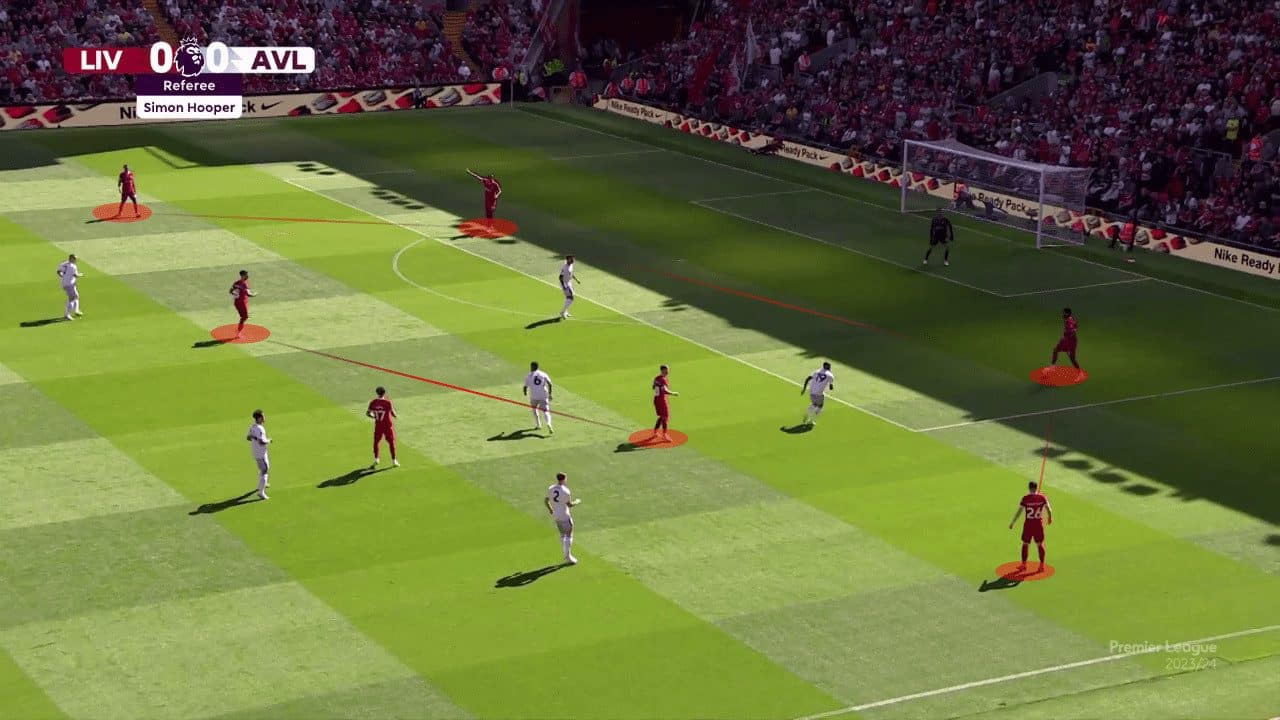
The main difference is in Alexander-Arnold’s positioning; rather than being inverted in the midfield, he is widely positioned on the right side, leaving his midfield position for the Hungarian player.
The reason they switched to this shape is firstly to have a wider first line of the build-up, so it’s harder for the opposition to press and more distance to cover, especially against a team who is well known for their strong high press as the Villians.
Besides, there is no gap between the two centre-backs behind “the problem we mentioned against Bournemouth”, and both Gomez and Matip cover the centre.
As shown, the shape of 4-2 with Gomez switching the play towards Alexander-Arnold in the right half-space, using John McGinn, who is between both Szoboszlai and Alexander-Arnold now.
If Alexander-Arnold was inverted, it would have been easier for McGinn to press as he would be centrally positioned with Alexander-Arnold only instead of covering two players when the ball was on Liverpool’s left side. Additionally, being in the centre and closer to the goal means a more dangerous position for the transition.
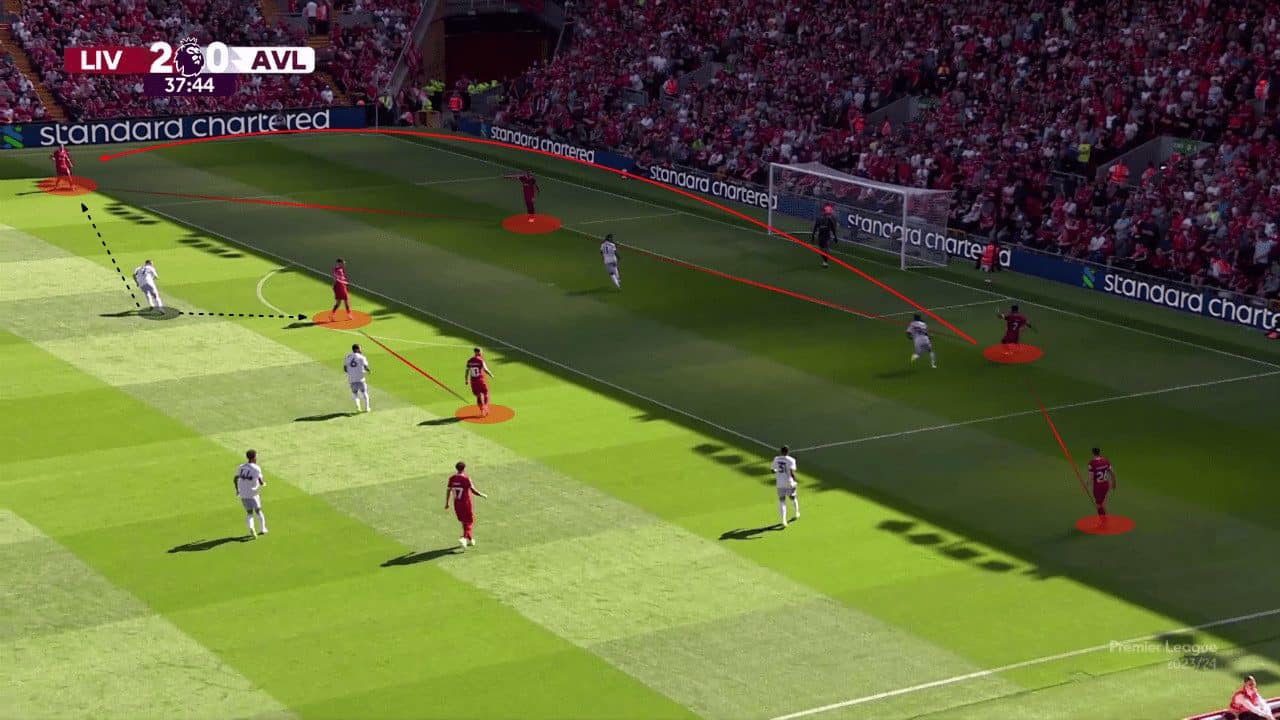
The same shape, while Watkins and Diaby couldn’t press Matip and Gomez as the wider build-up line. Consequently, Douglas Luiz had to press Matip, leaving Szoboszlai as Alexander-Arnold was pinning McGinn on the right side.
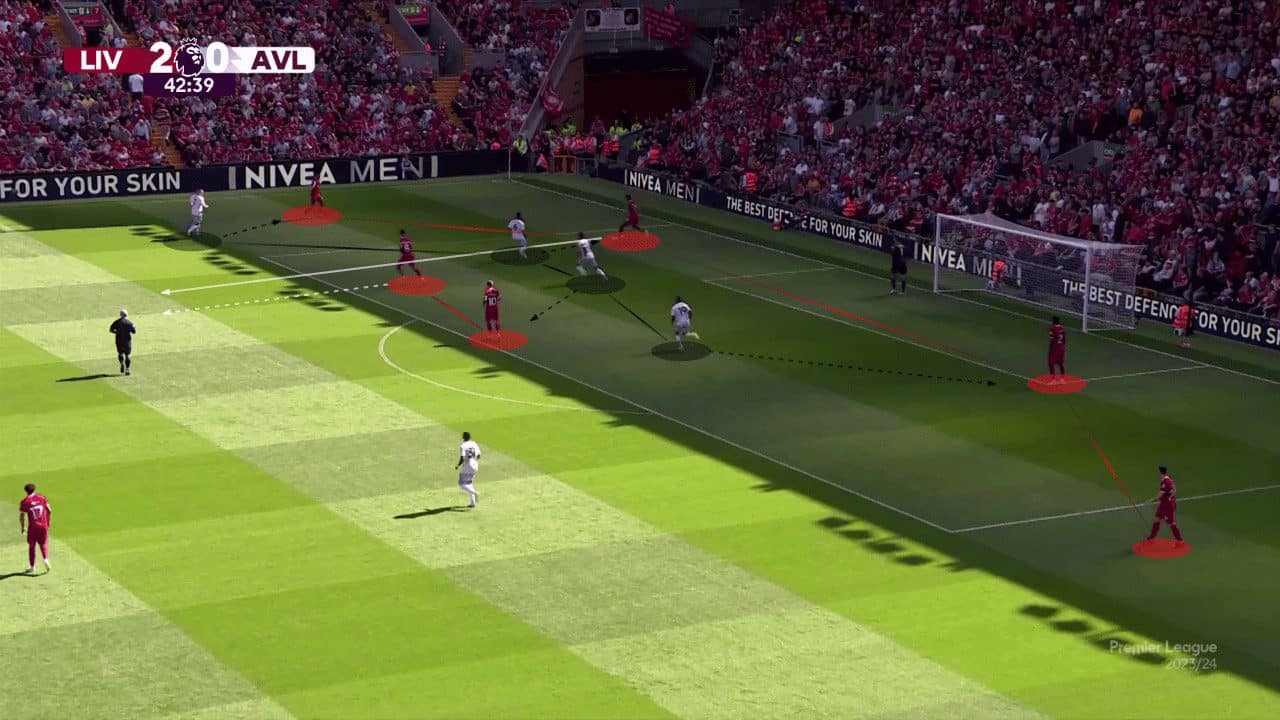
Matip found Szoboszlai behind the first pressing line of Aston Villa, and they easily escaped the press.
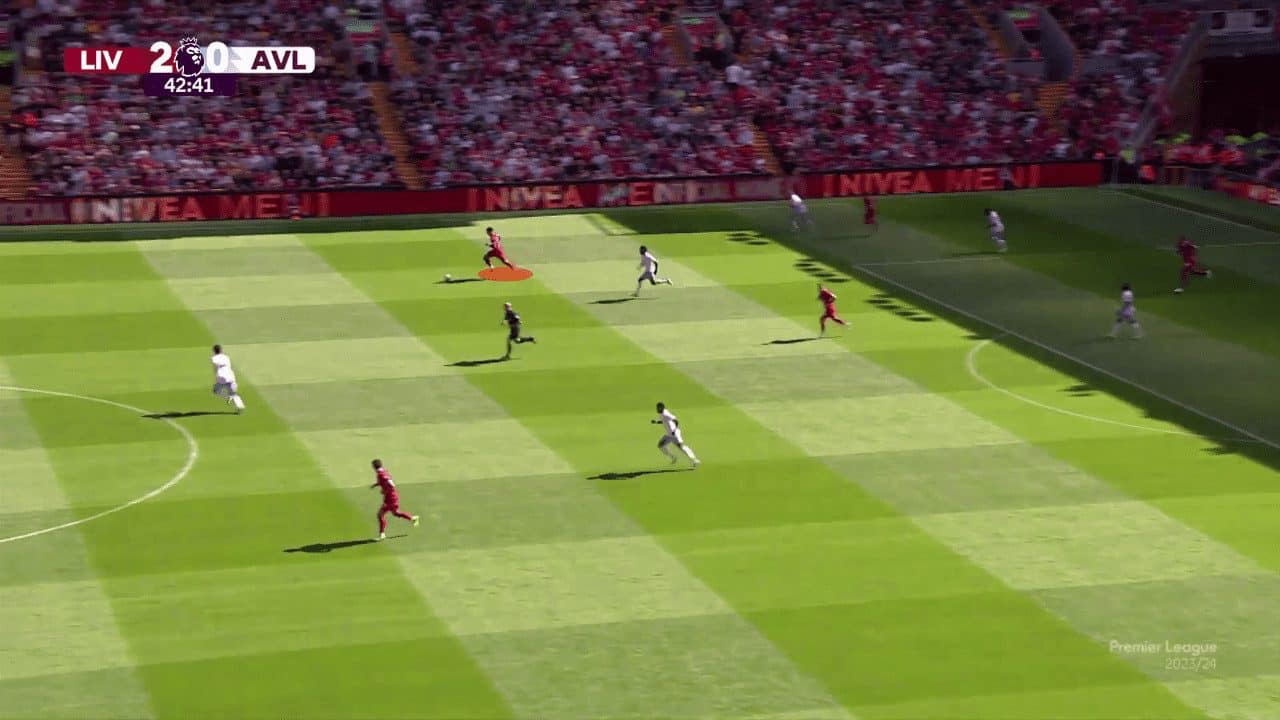
When you have better control of the game and frequently escape the press, you will be less likely to lose the ball and so deal with the defensive transitions.
Therefore, it’s not only essential to maintain your rest defence shape but also to have better control of the game, and that’s why Liverpool had a different shape in that game.
The Reds kept their winning run and defeated Villa by three goals to none and got their first clean sheath of the season.
On the other hand, their next game is an away trip against Wolverhampton Wanderers, one of the teams with lethal attacking transitions. With the suspension of Van Dijk and the injuries of Alexander-Arnold and Konaté, they have only one player in their starting backline, Robertson, but we will lay out this game separately at the end of the piece as it has a special sequence.
The progression phase
Liverpool had the same 3-2 shape during the progression phase. However, Alexander-Arnold and Dominic Szoboszlai usually switch their positions. In the example below, Alexander-Arnold is forming the double pivot with Mac Allister, just the same as the build-up shape at their first game.
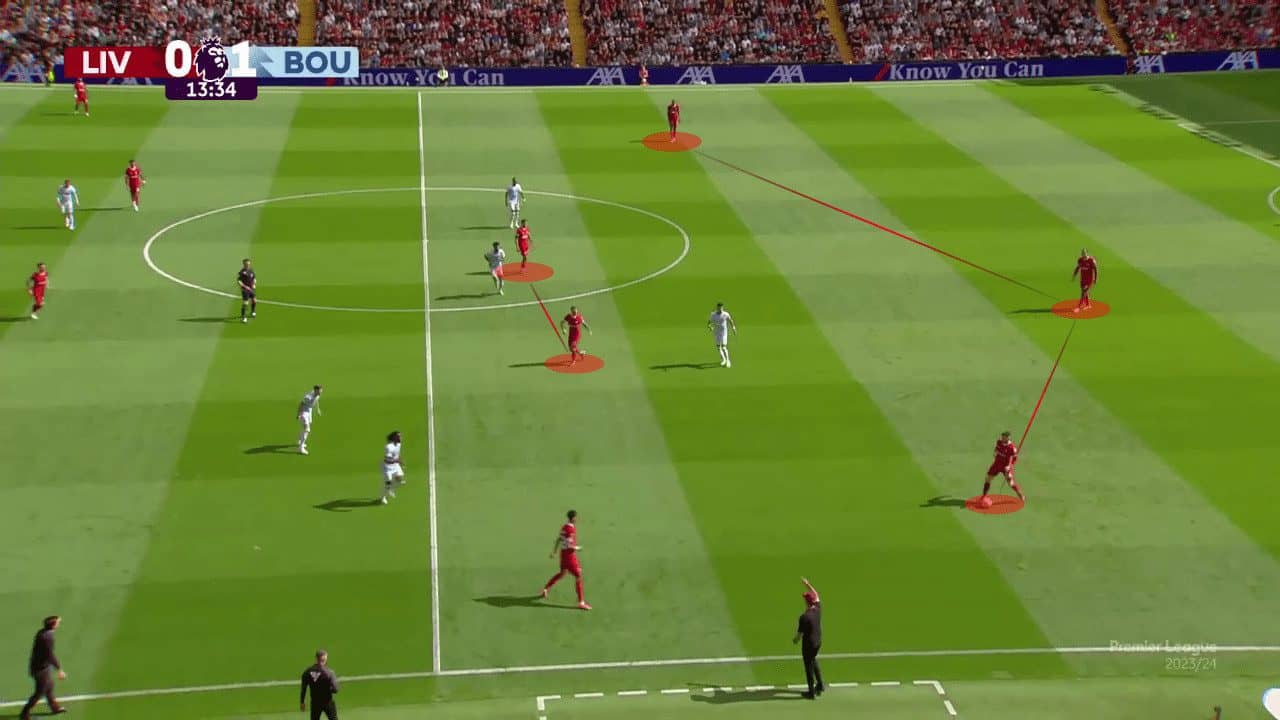
Another time, Szoboszlai is the one beside the Argentinian midfielder; meanwhile, Alexander-Arnold “shadowed” is positioned on the right flank.
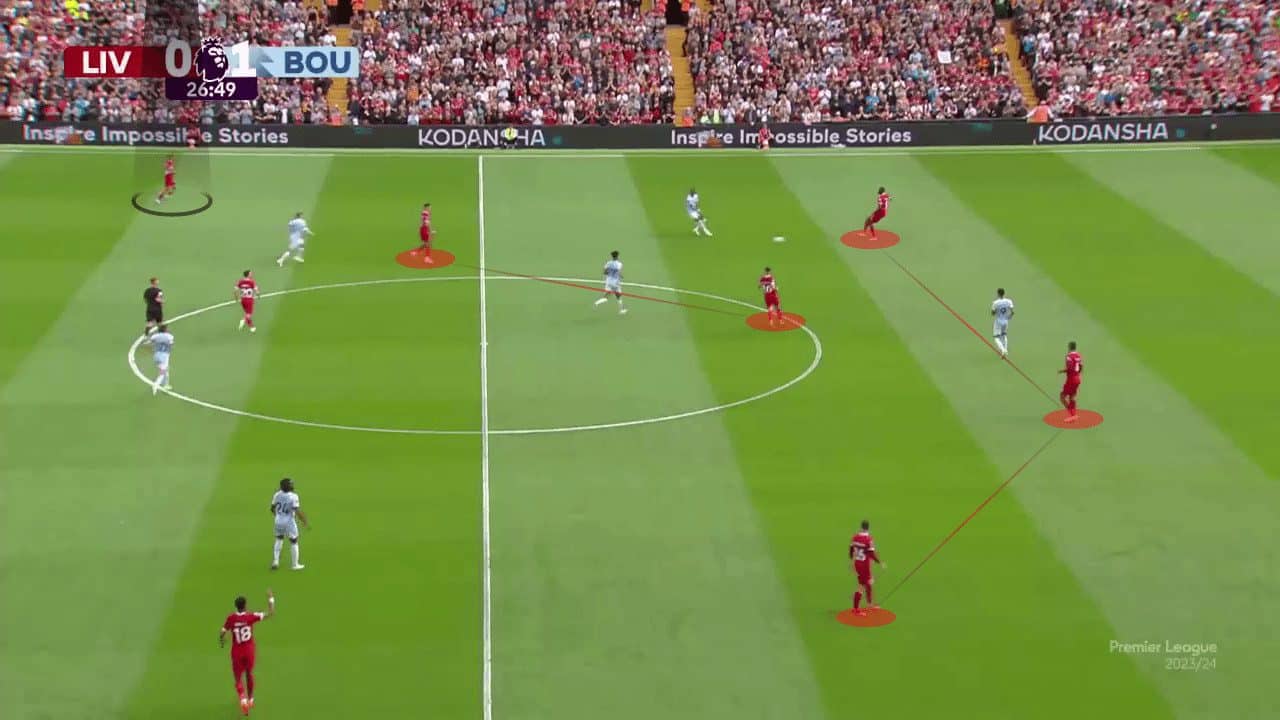
Liverpool faced a similar situation to the one we discussed earlier with the 3-2 rest defence. Bournemouth’s midfielder Joe Rothwell intercepted the ball and played the ball in the space between Konaté and Van Dijk for Billing.

Van Dijk had to step and press Billing on the flank while Robertson had to make the same run to cover the centre in which Solanke was present. Notice again how Semenyo, the goal scorer, is free utilising the space left by the Scottish full-back, but Van Dijk brilliantly anticipates Rothwell’s pass to end a dangerous transition.
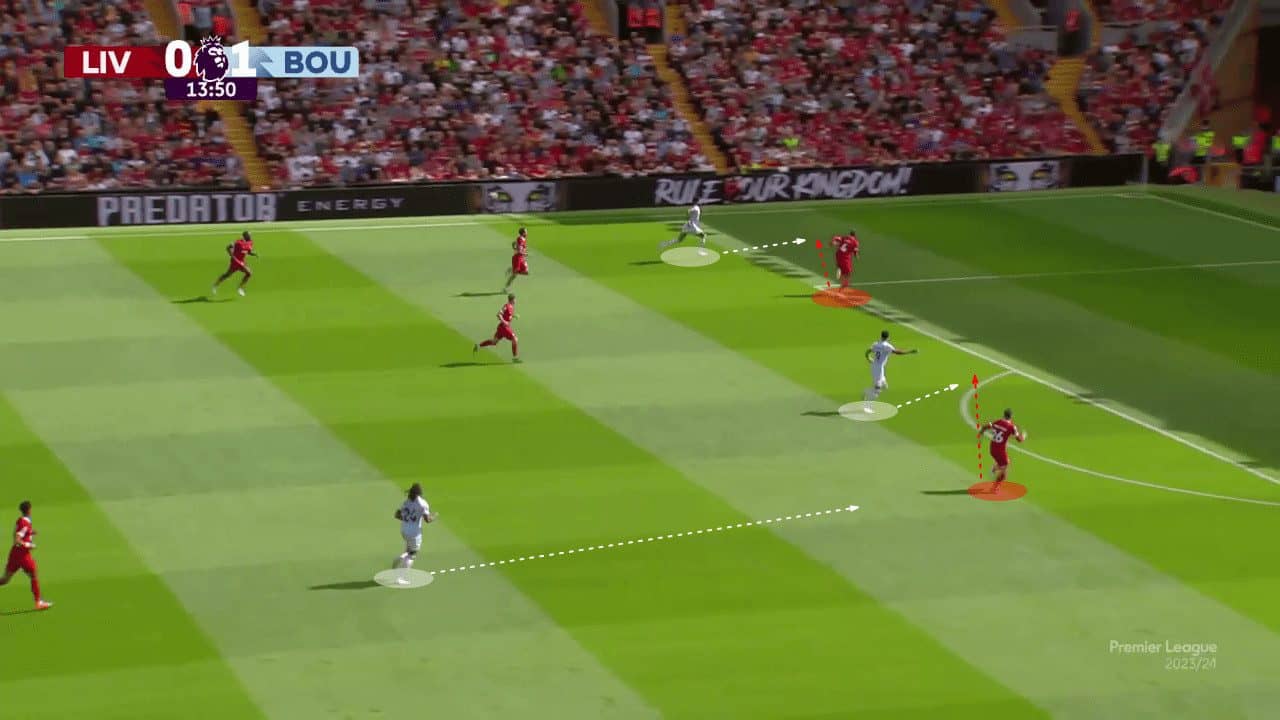
Moreover, they maintained the same shape against Newcastle although after Van Dijk’s red card.
We can observe the back three of Robertson, Gomez and Matip with Endō and Mac Allister ahead of them, and Alexander-Arnold stays widely ready to get forward.
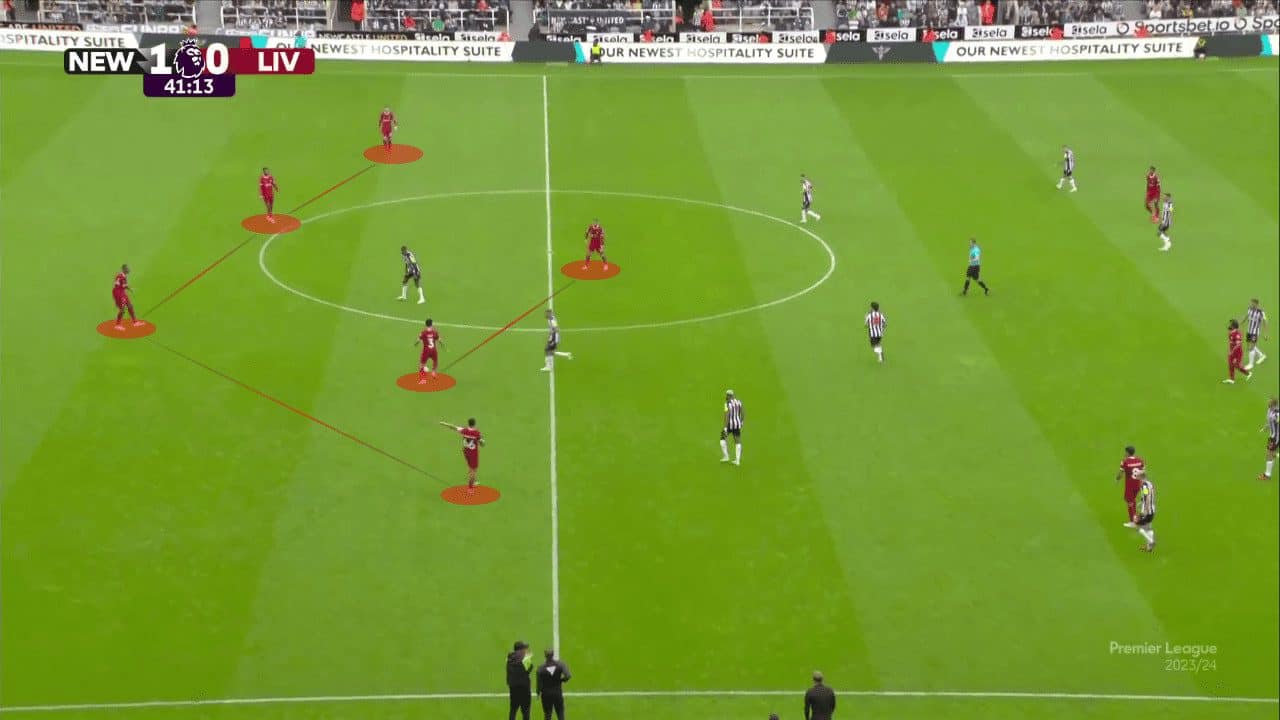
Identically, they kept the same shape versus Aston Villa.
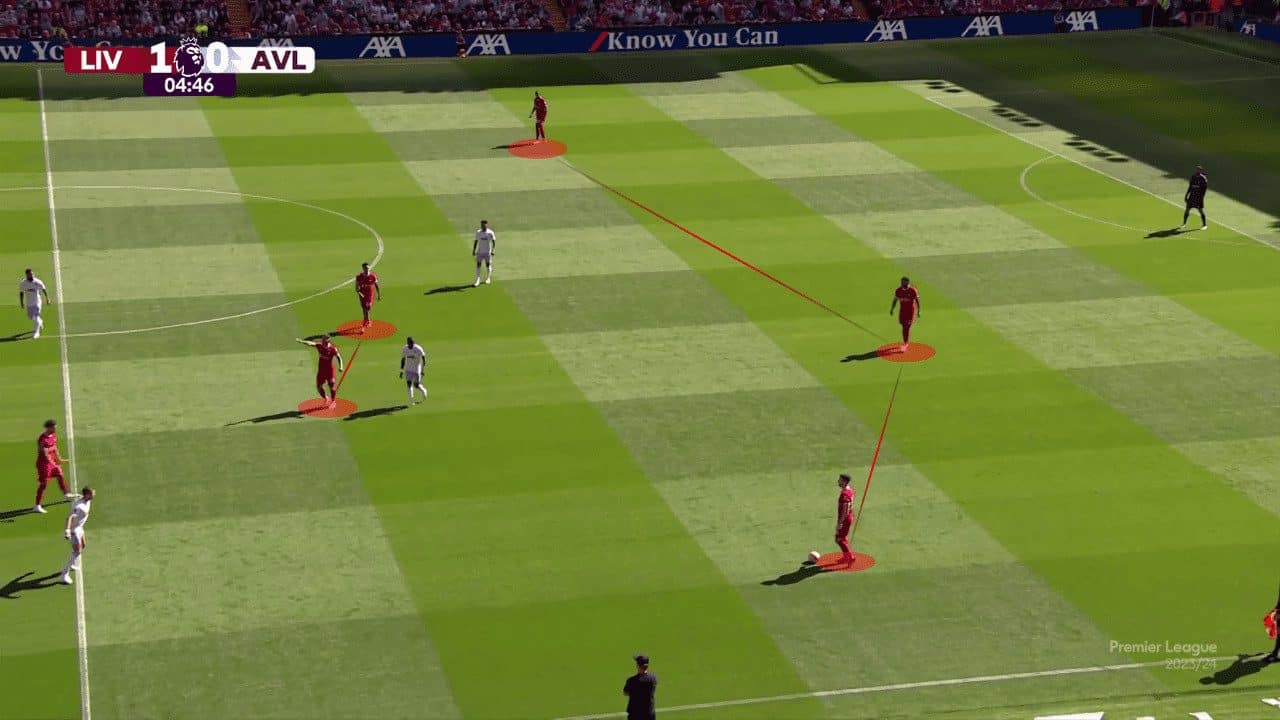
The new observed thing was that Alexander-Arnold dropped the first line with Matip stretching the field from the right side to be positioned like a right-back and take advantage of his brilliant ball carrying.
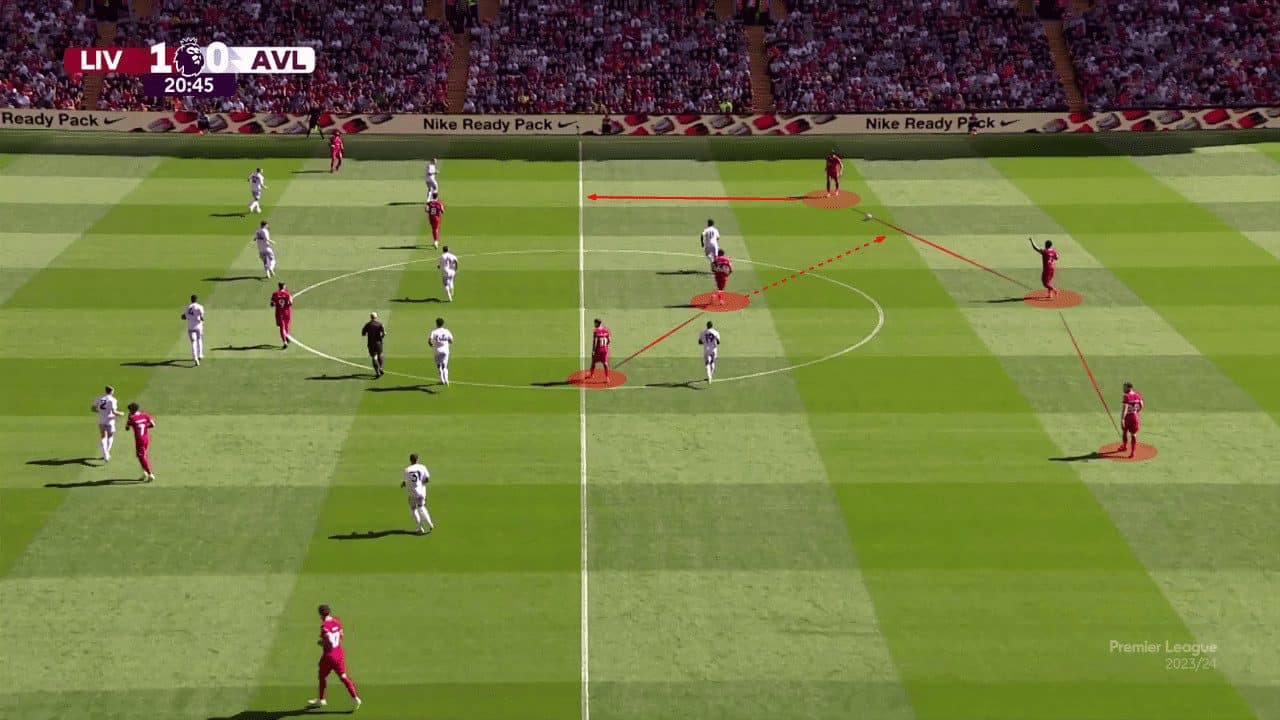
Arnold’s new positioning turns the shape into 4-1, and the aim of having Alexander-Arnold here is to cover Matip if he progresses with the ball along with escaping the marking, using his exceptional passing and vision to help in progression and chance creation.
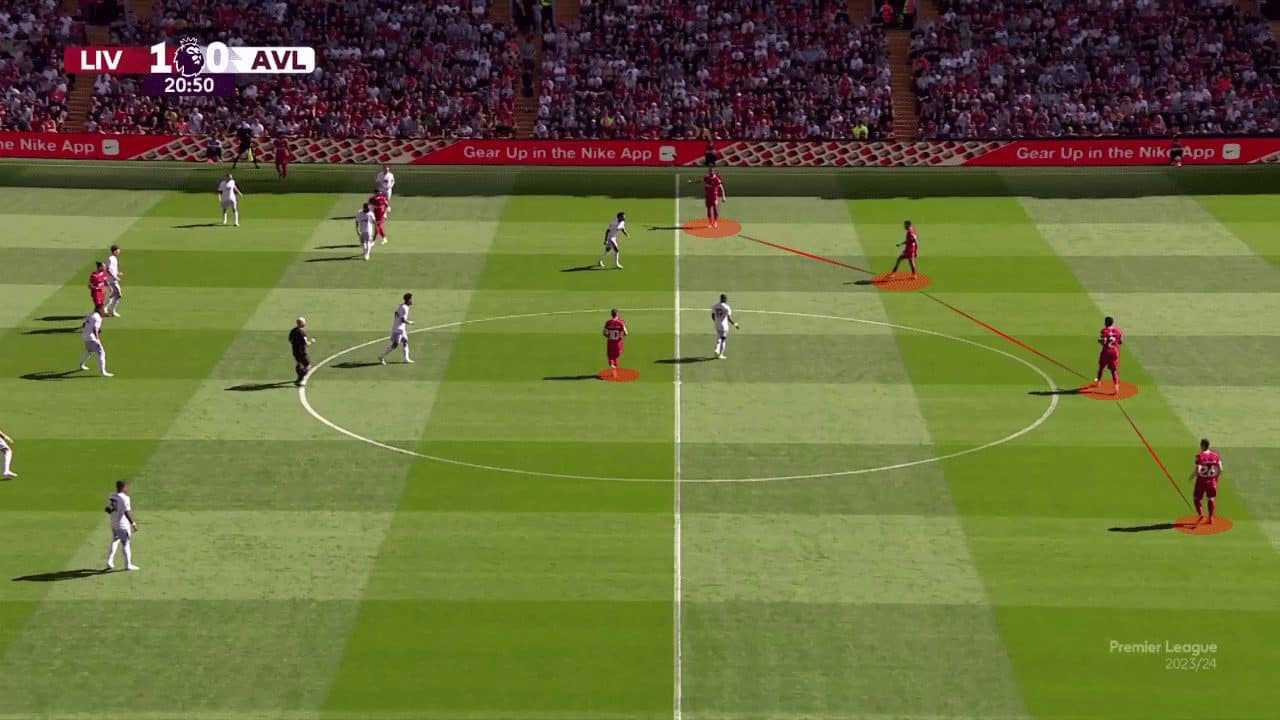
Arnold’s pass found Mohamed Salah behind Villa’s defensive line; Salah flicked the ball towards Núñez, whose shot turned into a goal after bouncing back from Matty Cash.
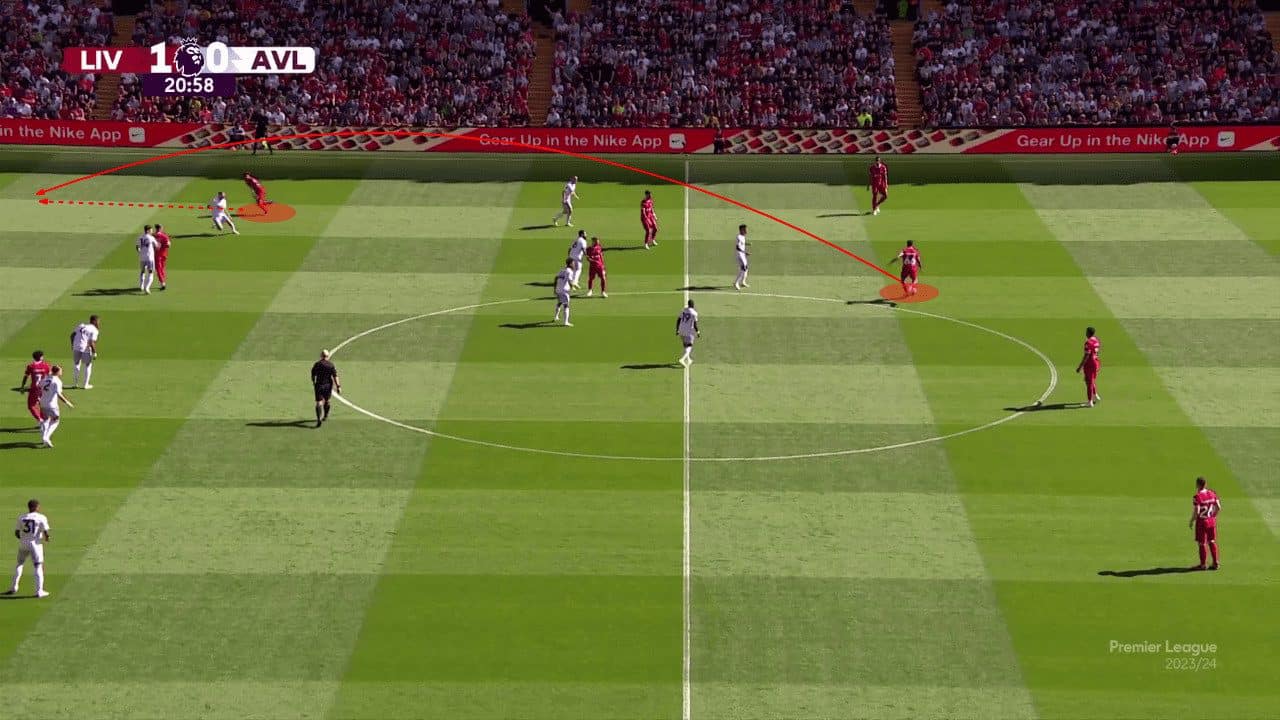
That variation of Alexander-Arnold’s positioning, even sometimes switching with Szoboszlai, gave them complete control of the game and minimised the moments of Villa’s counters.
With the 3-2 shape now, you rightly guessed the only problem they might have faced.
Again, with Villa’s attacking transition, Andrew Robertson is running centrally to cover the space which Moussa Diaby is running in, leaving a space for Leon Bailey, the right winger, to freely come from behind “the same run as Bournemouth’s Semenyo”.
Emery’s side didn’t make use of this situation as Mac Allister anticipated the pass.
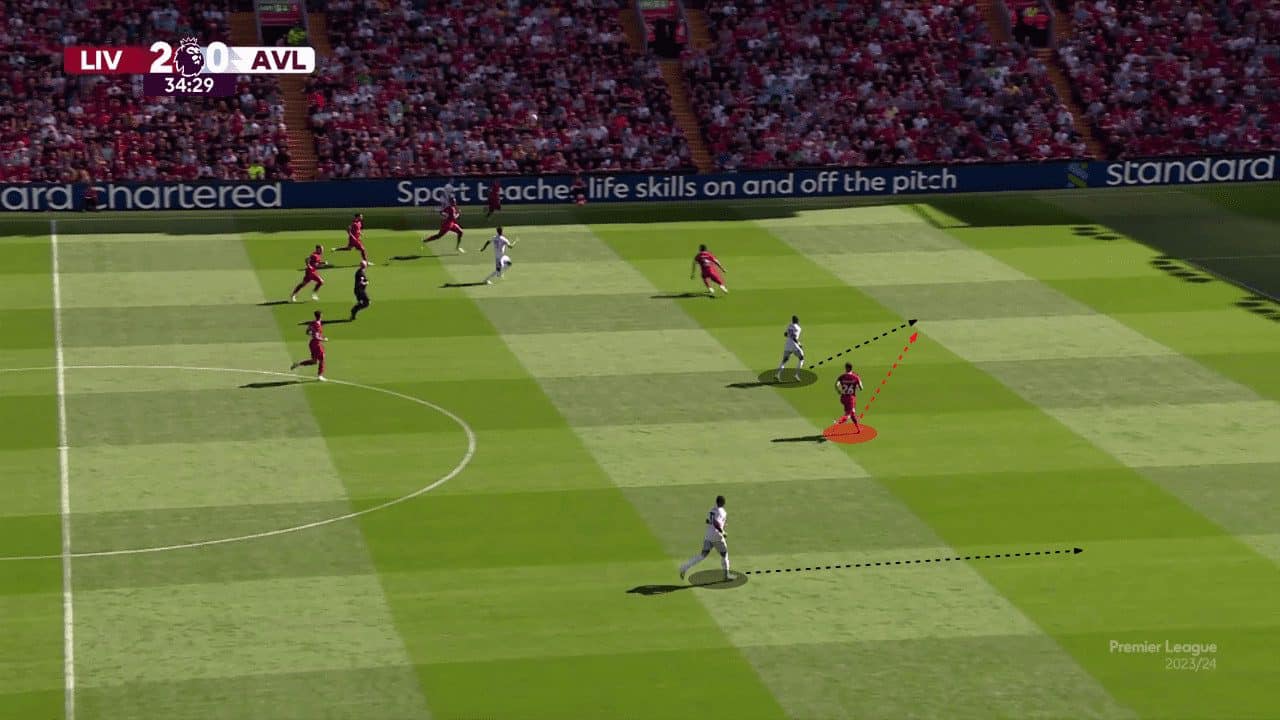
The final third
In the final third, things were slightly different, as one of Alexander-Arnold or Robertson are needed to join the attack from the wide areas or the half-space. The other stays to leave their rest defence shape in a 2-2 or a box-like shape with the two centre backs — Van Dijk and Konaté — forming the base of the box alongside Mac Allister with either Robertson, Alexander-Arnold or sometimes Szoboslai forming the other side of the box-shape.
As shown below here, Mac Allister and Robertson are staying centrally as Alexander-Arnold is in the early cross position.
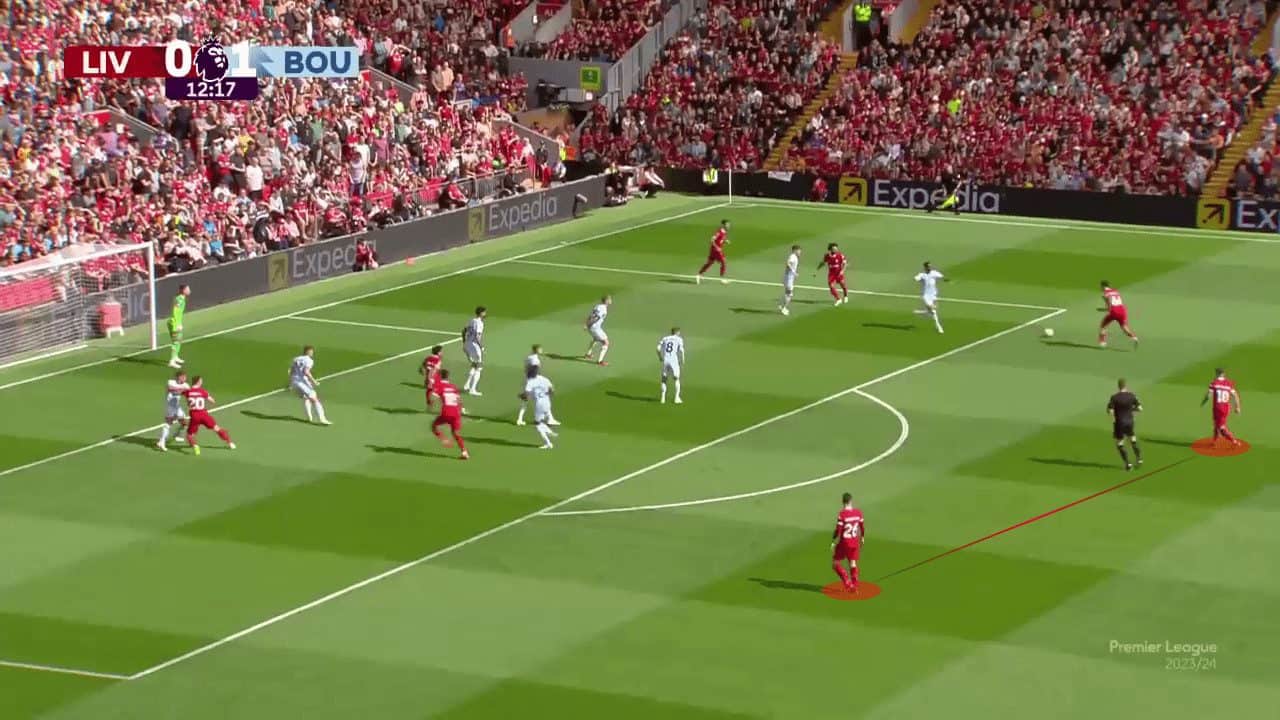
Meanwhile, Robertson and Mac Allister are centrally positioned for the moment of transition. Konaté had the rule to man-mark any forward of the opposition as here he was marking Solanke.
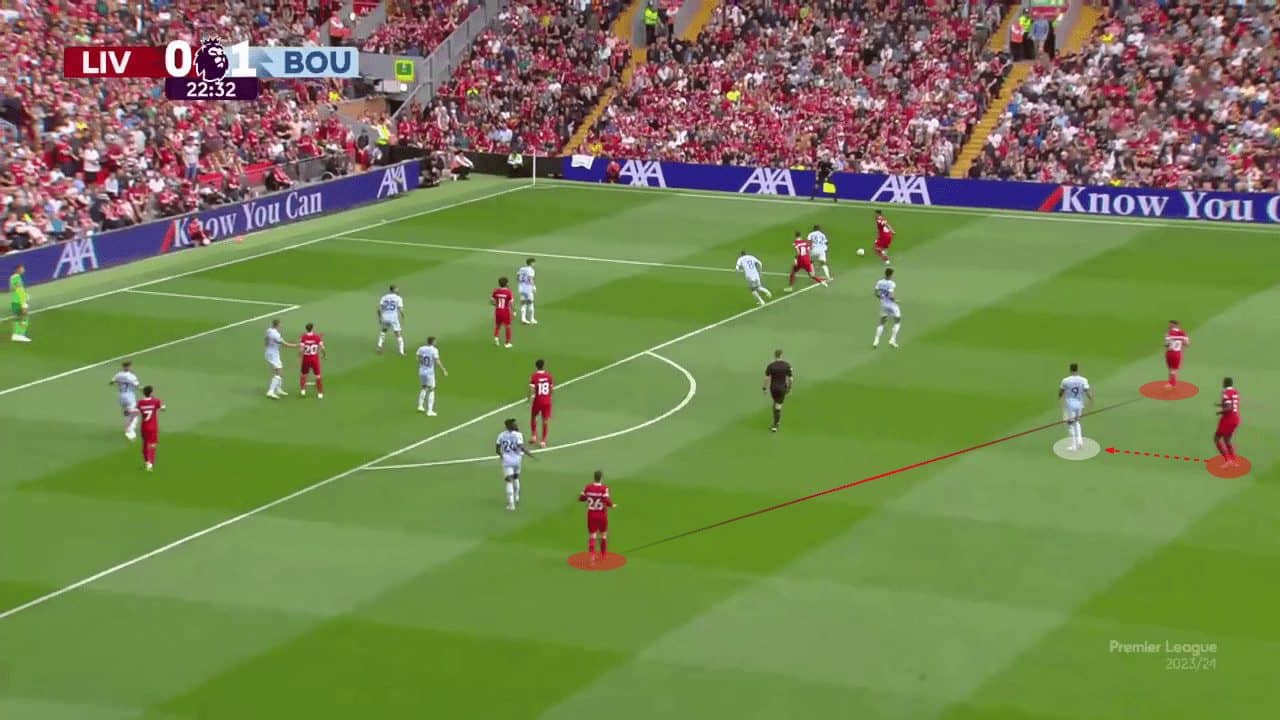
Again, Alexander-Arnold is shadowed and widely positioned on the right side while Robertson and Mac Allister are waiting centrally, and the away side is beginning an attacking transition.
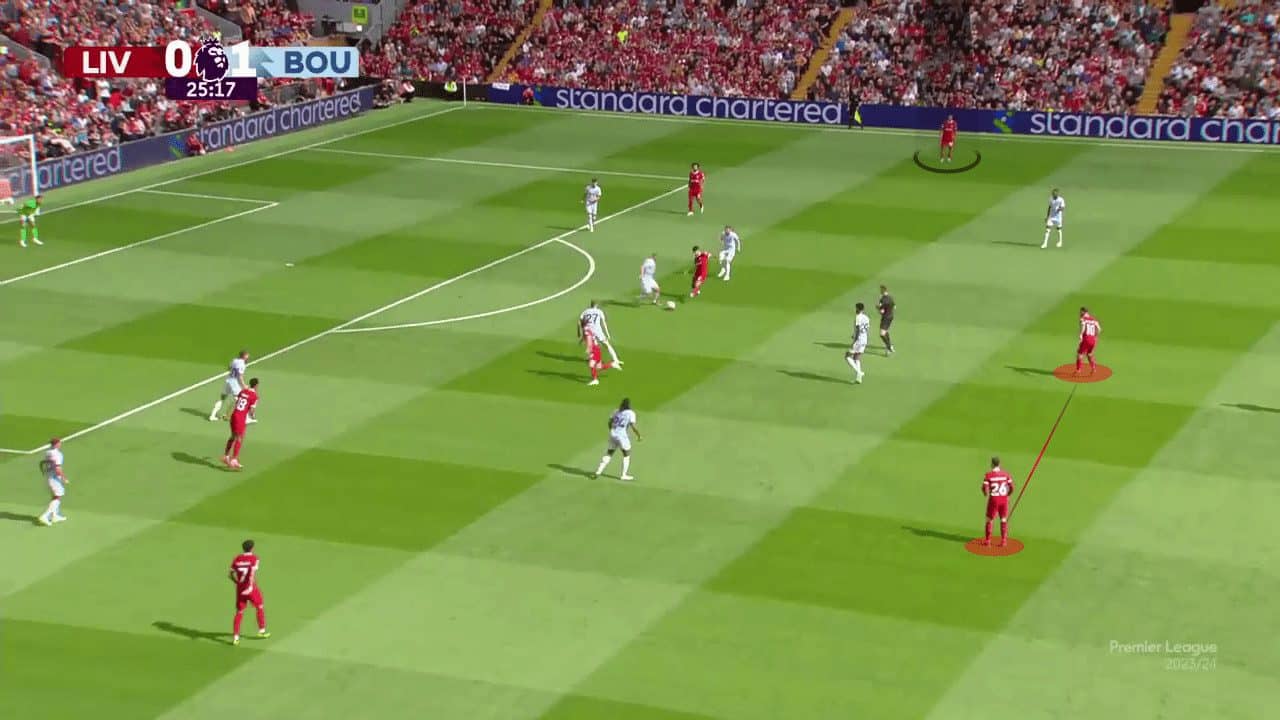
Here, we can see the 2-2 shape, Van Dijk and Konaté, on the first line and in front of them, Robertson and Mac Allister.
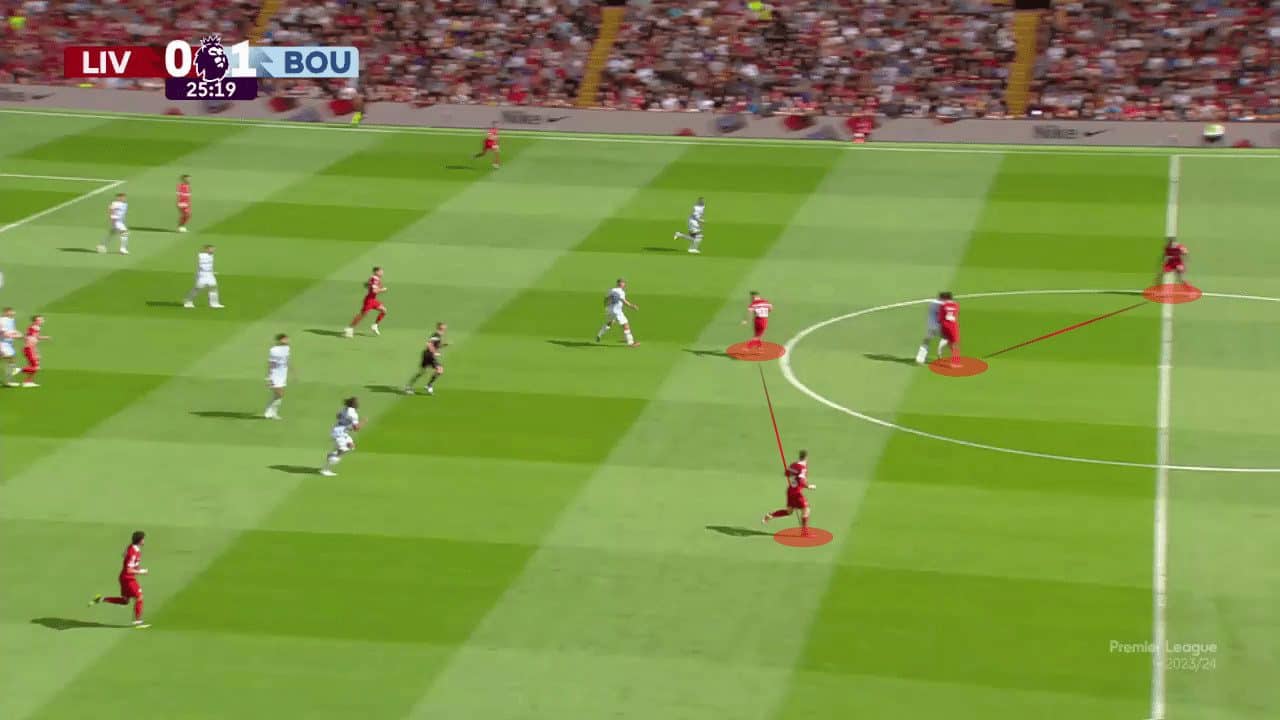
However, Andrew Robertson was mainly focused on joining the first line rather than staying in the centre to cover with Mac Allister and again, we can observe below Antoine Semenyo had the free space. Still, Van Dijk and Robertson intercepted the ball from Solanke.
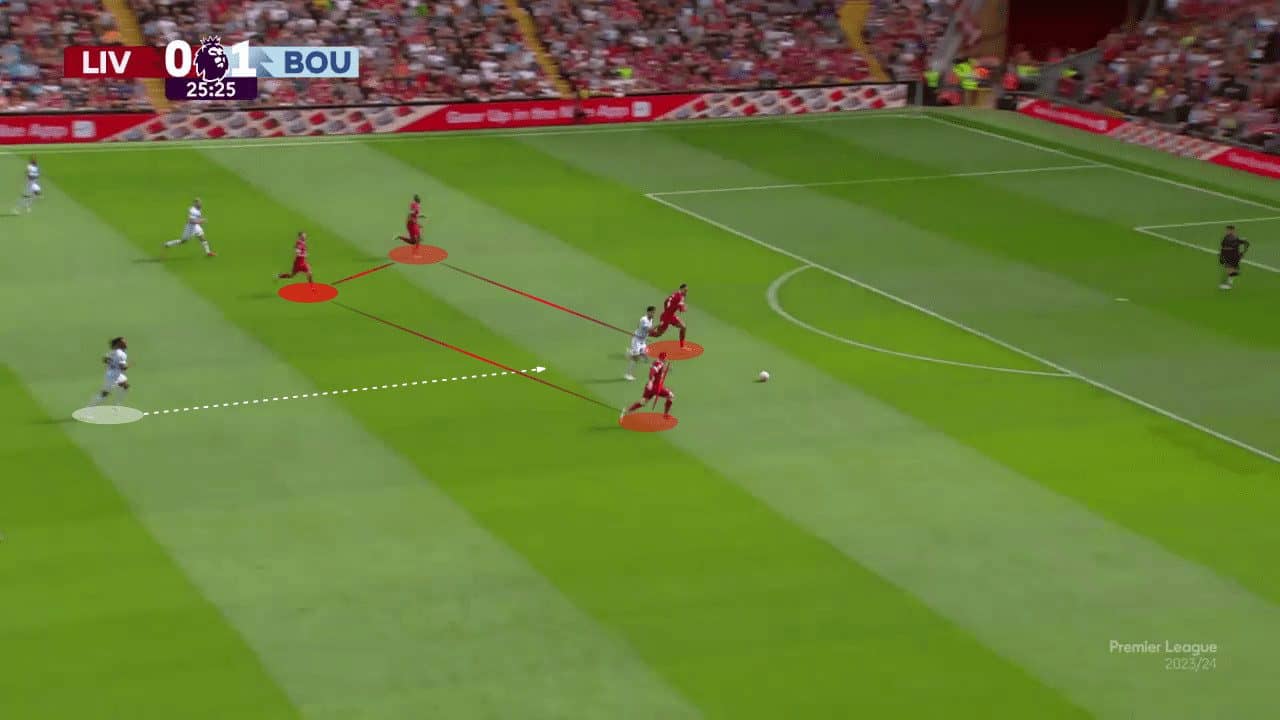
Later in the game, Alexis Mac Allister got sent off in the fifty-eighth minute, and the score was 2-1 for Liverpool, which meant they had to play almost half an hour with only ten men and still had to control the game. So, how do they deal with it?
Endō replaced Coady Gakpo in midfield just three minutes after the red card. The home side prioritised maintaining the same rest defence shape even though they were one man down, especially having two midfielders in the centre.
Here, the same backline of three, with both Szoboszlai and Endō forming g the second line of two players.
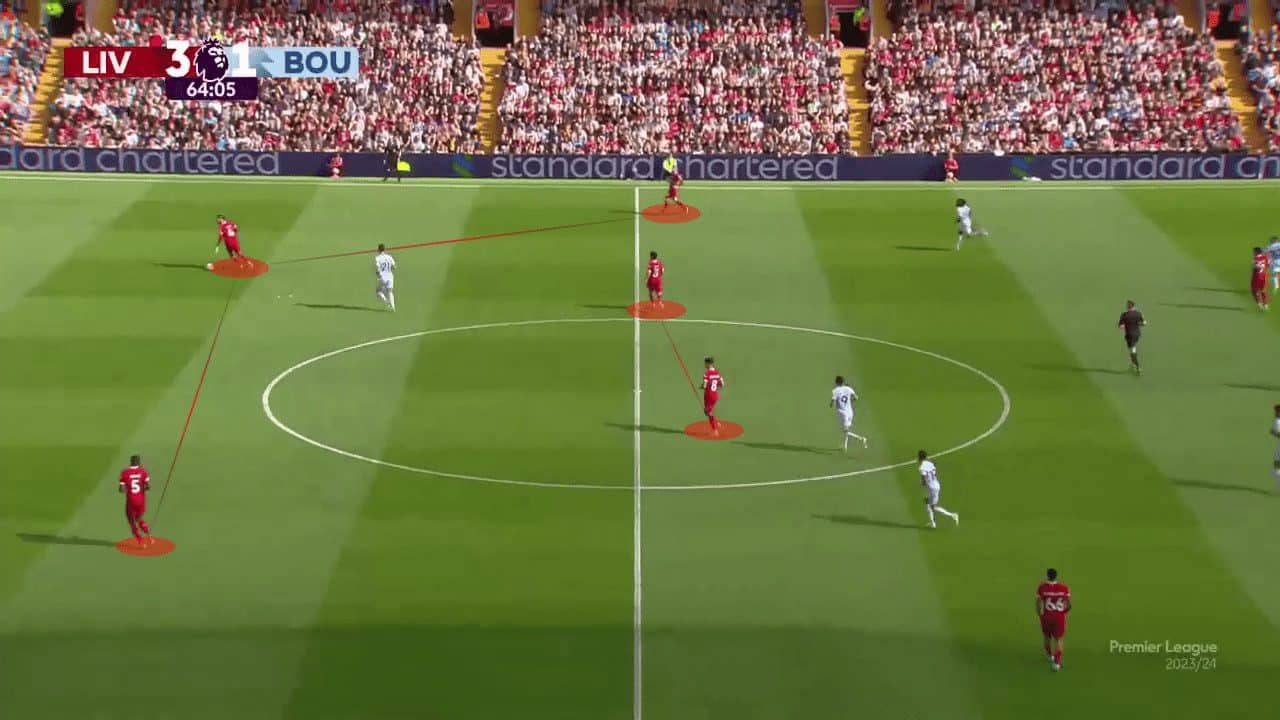
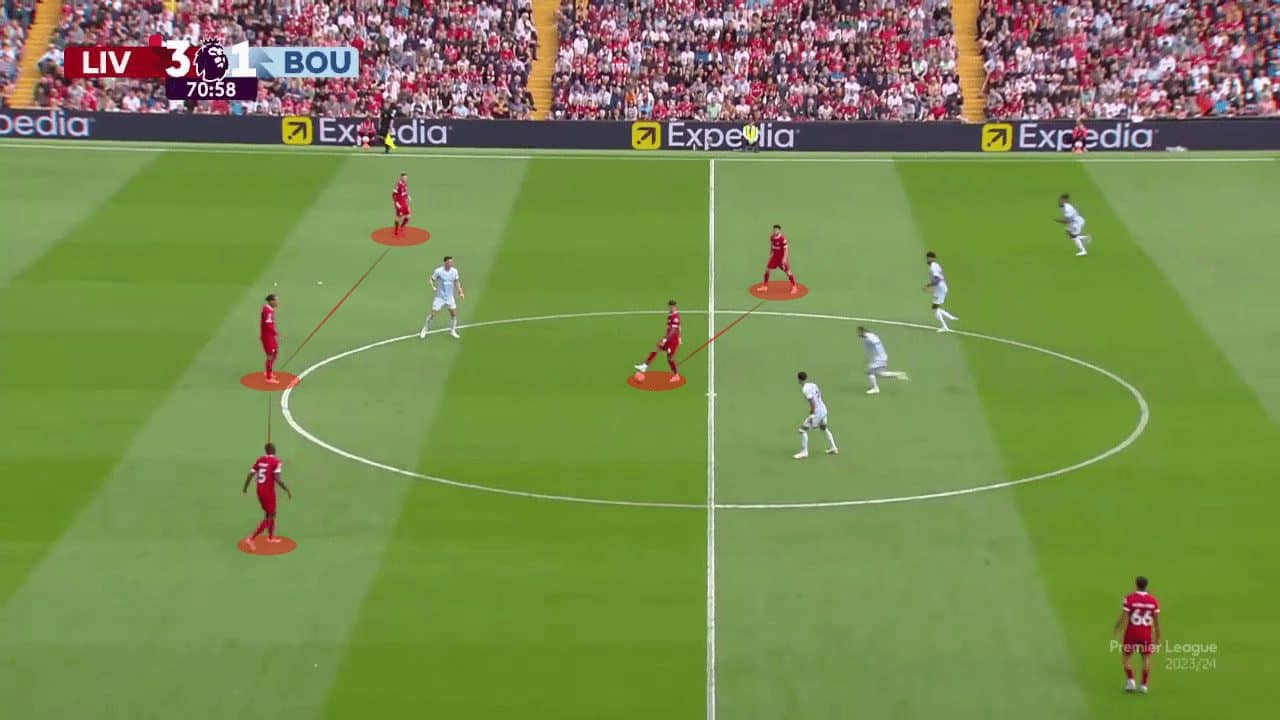
Liverpool won that game 3-1, and their rest defence played a significant role in shutting down the opposition’s attacking transitions even after the red card.
Furthermore, they have been in the same situation as we mentioned against Newcastle with one man down and kept the same 3-2 shape with midfield of Mac Allister and Endō.
Here, the home side is starting an attacking transition and could pass both midfielders with Jeolinton’s pass to Gordon alongside Alexander-Arnold, who is widely positioned and not a part of the midfield rest defence anymore.
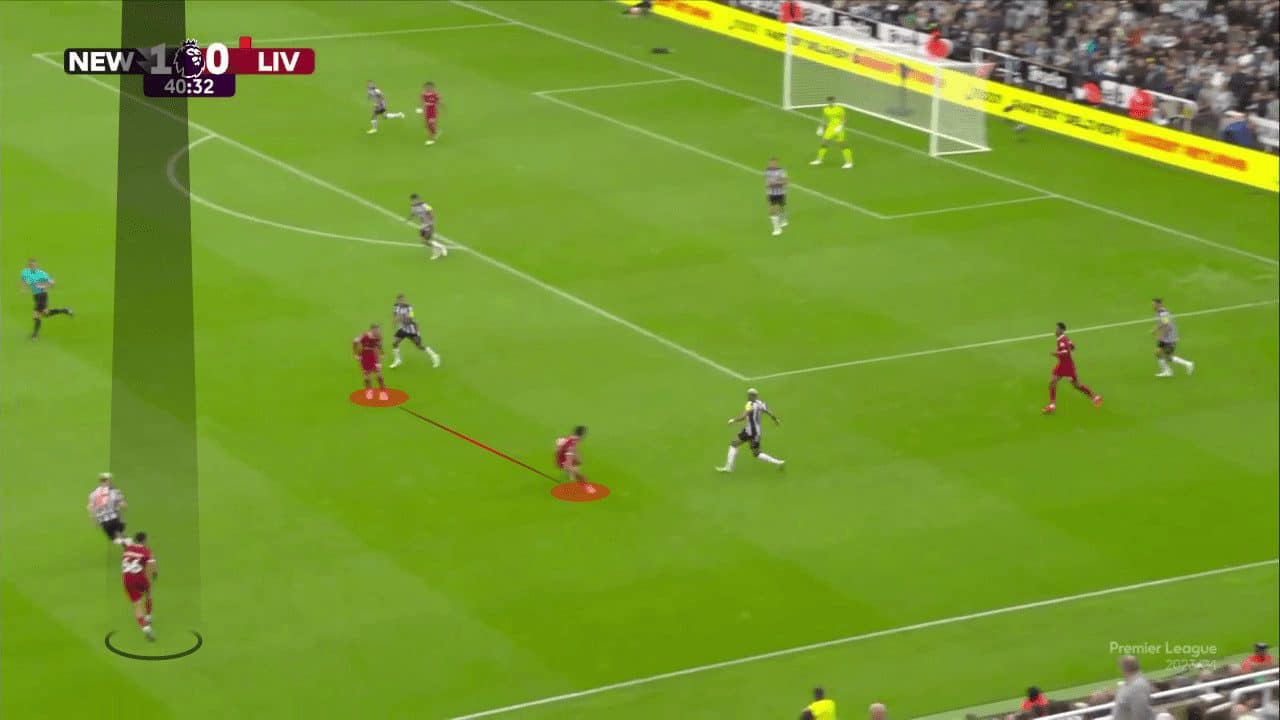
It turns into a 3v3 situation, and again, because of Miguel Almirón’s run, Robertson is forced to go backwards, so more space is created for Gordon.
Thanks to the excellent coordination between Robertson and Gomez, who stepped on pressing Gordon, the situation ended safely on Liverpool’s goal.
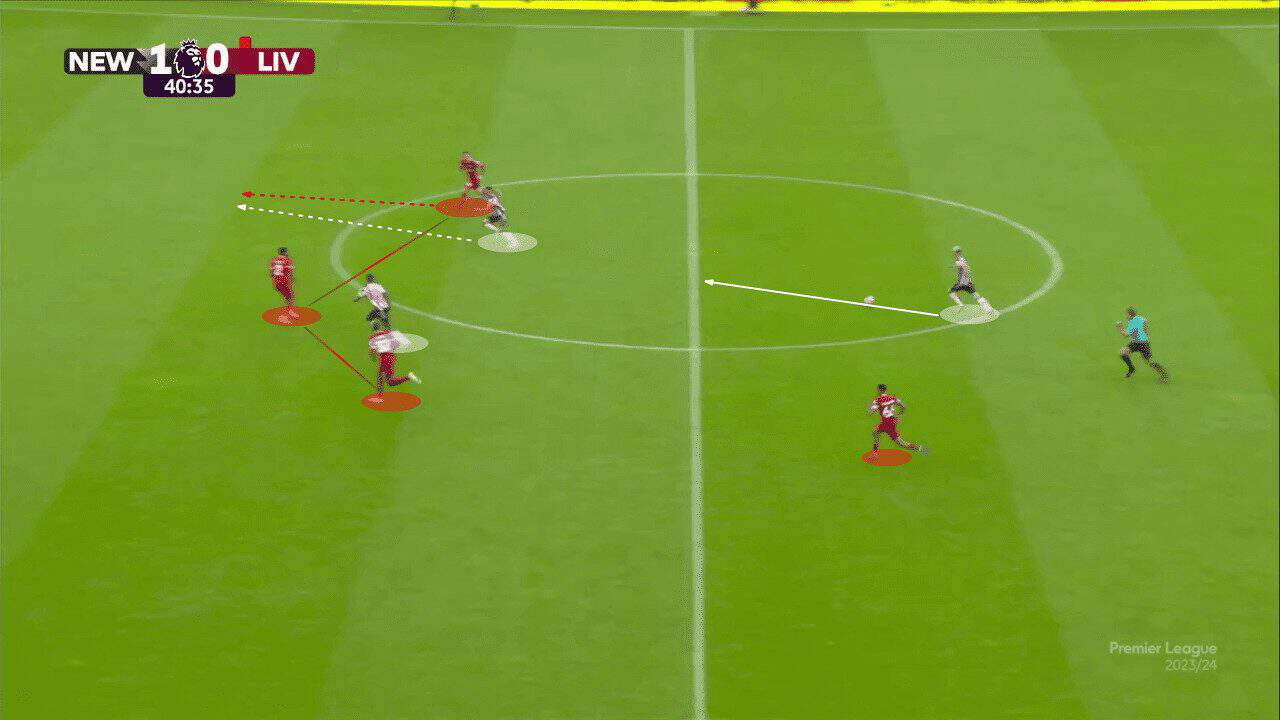
From the past situations against Bournemouth and Newcastle, we can conclude that when they had to play with ten men, they chose to play with Alexander-Arnold as a traditional right-back as an alternative to have him inverted.
During the fifth game week, Wolves under Gary O’Neil were hosting Liverpool at Molineux Stadium; Liverpool at that time had a challenging game to stop Wolves during the counters while missing three out of the four starting defenders, as we mentioned.
During the build-up, the away side relied on a 4–2 rest defence shape with Gomez as a traditional right-back while Szoboszlai and Mac Allister as a double pivot against a 4–4–2 high press from Wolves.
Matheus Cunha and Jean-Ricner Bellegarde passively pressed the centre backs while cover shadowing the pass towards the pivot, with Pedro Neto and Hwang Hee-chan pressing the full-backs.
Interestingly, Neto played as a left winger, not suitable as usual, because Liverpool’s right-back, either Alexander-Arnold or even Gomez, inverts in possession so he can run in behind that inverted full-back or drag him out of the centre, freeing up a space for Cunha to drop and receive.
We can see below Liverpool’s 4–2 build-up with Szoboszlai and Mac Allister as a double pivot, while Neto here is responsible for pressing Gomez.
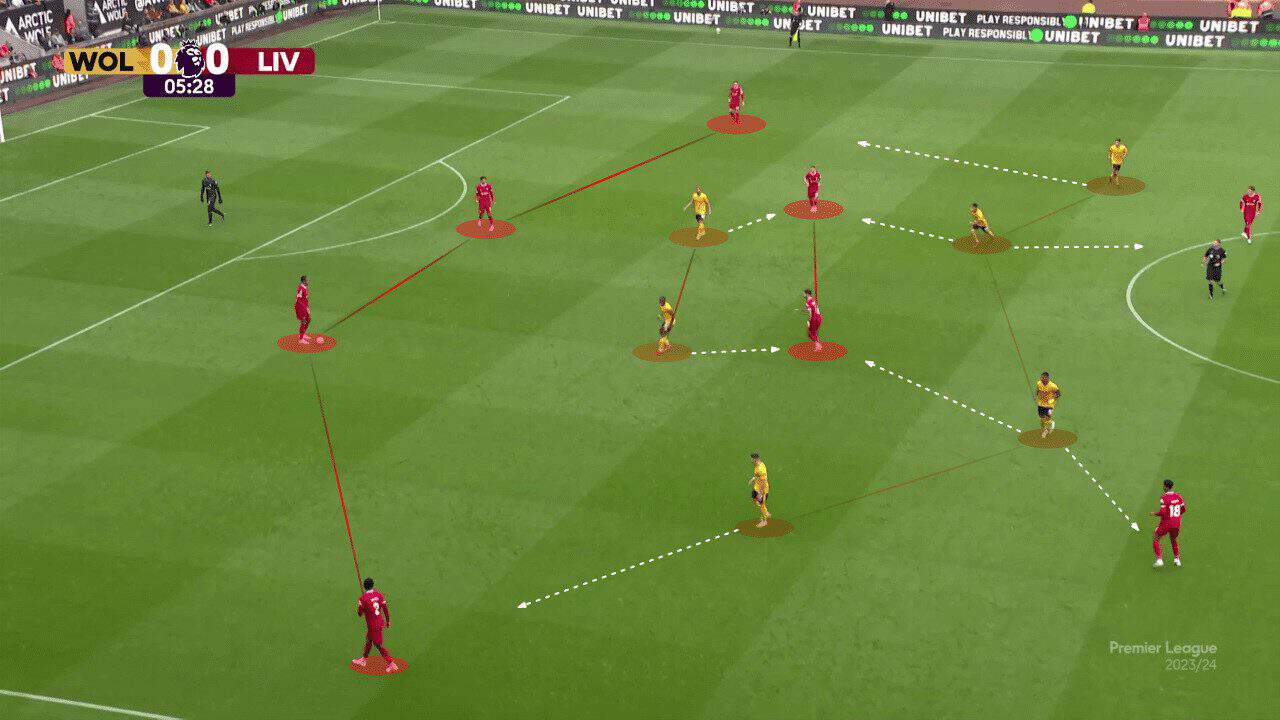
Furthermore, during progression, Liverpool had their normal 3–2 shape, the base of Robertson, Jarell Quansah and Matip alongside Mac Allister and Gomez as the pivot, with Szoboszlai pushing forward towards the right half-space.
The presence of Gomez here, who is a natural centre-back, is clearly for the rest defence.
In contrast, Wolves mid-press had a different approach, with Bellegrade and João Gomes pressing the pivot while Hwang stayed with Robertson and Neto pressing Matip instead of Gomez.
That made both wingers Hwang & and Neto have a distance on the flanks to utilise during transitions and caused many threatening situations in the first half. Specifically, Neto is facing Matip, who is slower than him.
He is the 3–2 shape during progression, with Gomez beside Mac Allister in the midfield. Here, Neto is marking Matip instead of Gomez.
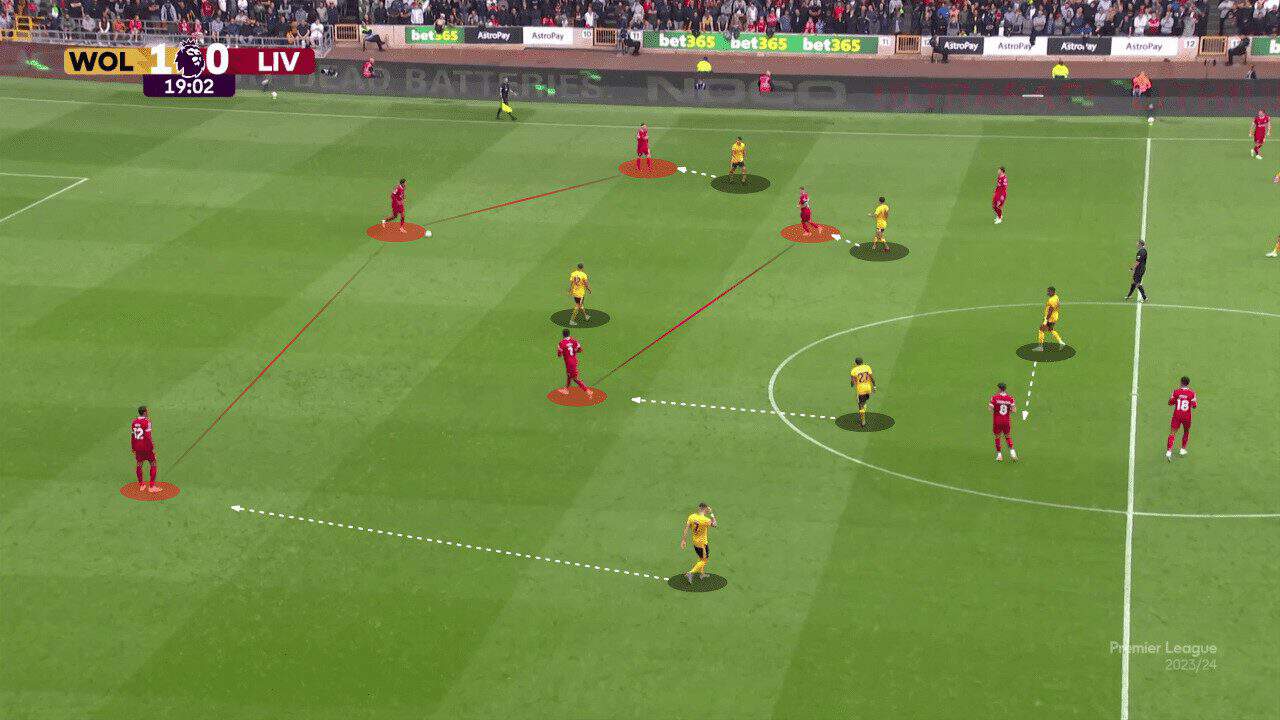
And the 3–2 rest defence shape during the final third attacking below with Neto here is still marking Gomez.
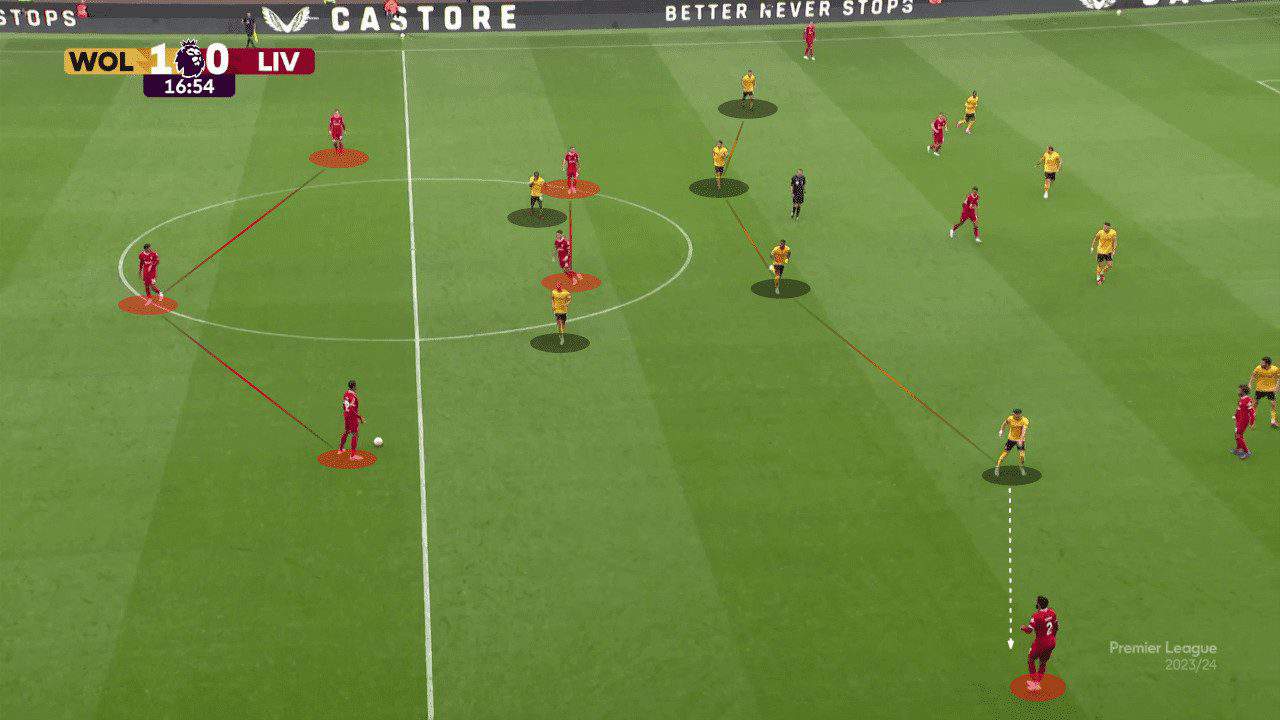
Therefore, when Gomez is positioned as a right-back, he is being marked by Neto, while when inverted, Neto is pressing Matip, as this will be essential information for the second half.
Their attacking transitions earned them the opener in the first half; Cunha was Dropping while Neto was running behind the inverted full-back Gomez.
Despite having two central players here, Mac Allister and Dominic, their nature of being more of a box-to-box midfielder didn’t help the Reds here.
Cunha received and played the ball towards Neto behind Gomez.

Later, Neto’s cross finds Hwang, who scored.
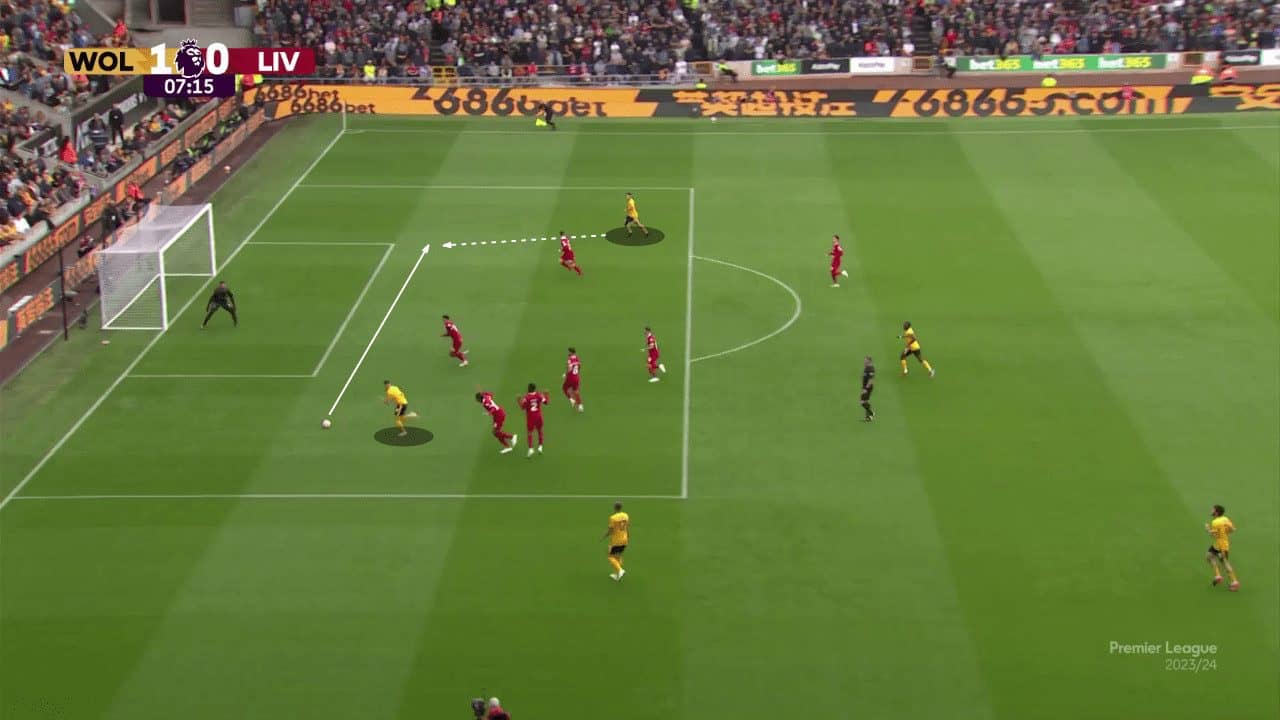
Another time, we can see the shadowed Neto is running on the left side with Matip in a 1v1.
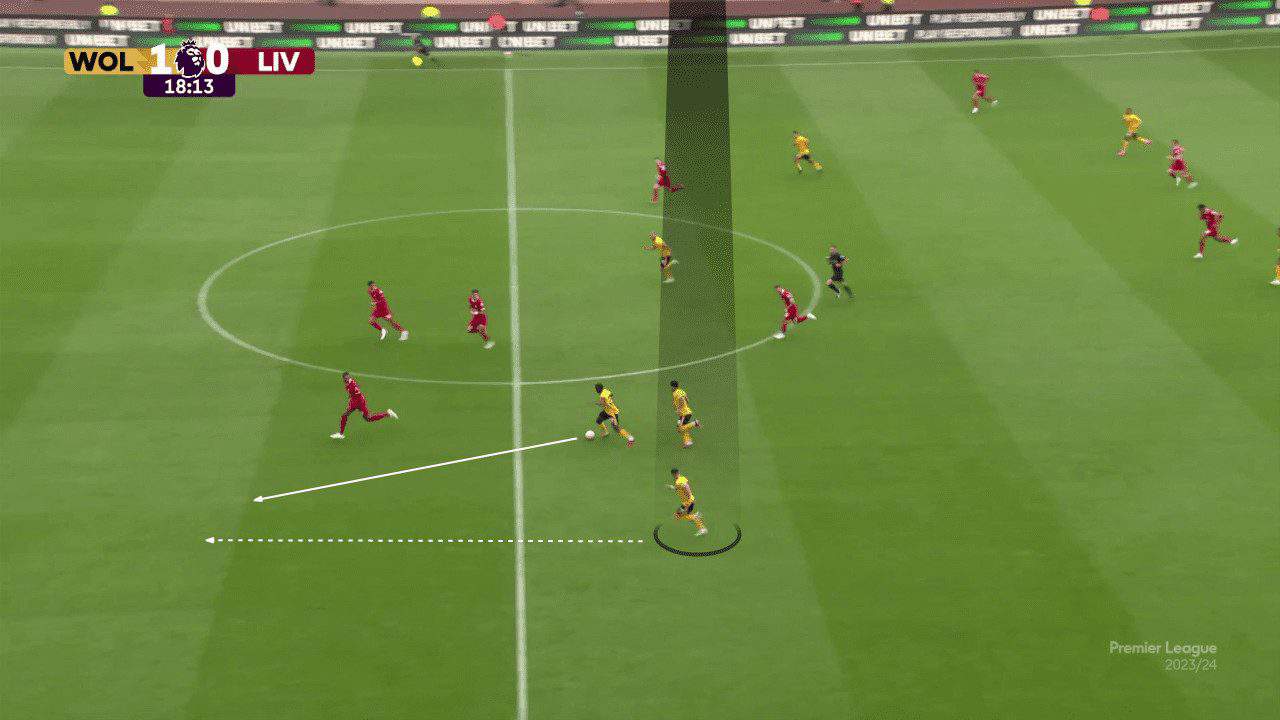
Wolverhampton earned a 1–0 score in the first half and had several dangerous situations from transitions. Anyhow, how did Liverpool adapt in the second half?
With Luis Díaz replacing Mac Allister, Liverpool changed their rest defence shape for a 2–2 with Jones dropping alongside Szoboszlai. Moreover, both full-backs Robertson and Gomez pushed much higher to provide the width on each side.
The high positioning of Liverpool’s full-backs dragged both Neto & Hwang backwards as they had to track back. As we mentioned during the first half, Neto — Wolves’ best player in transitions — was marking Gomez when he was positioned as a standard right-back, so during the second half, Gomez kept his high position as a right-back to drag Neto with him.
The same as Robertson and Hwang on the other side, so now they are too far from reaching the ball during the transition and have to travel much more distances. Also, it’s essential to mention that Liverpool kept having two players in the centre to shut down Cunha.
As shown below, the rest defence’s new shape of 2–2 with Neto (Shadowed) is pinned by Gomez (highlighted in red) on Wolves’ left side, the same as Robertson and Hwang. Díaz’s positioning helped in dragging the goal scorer.
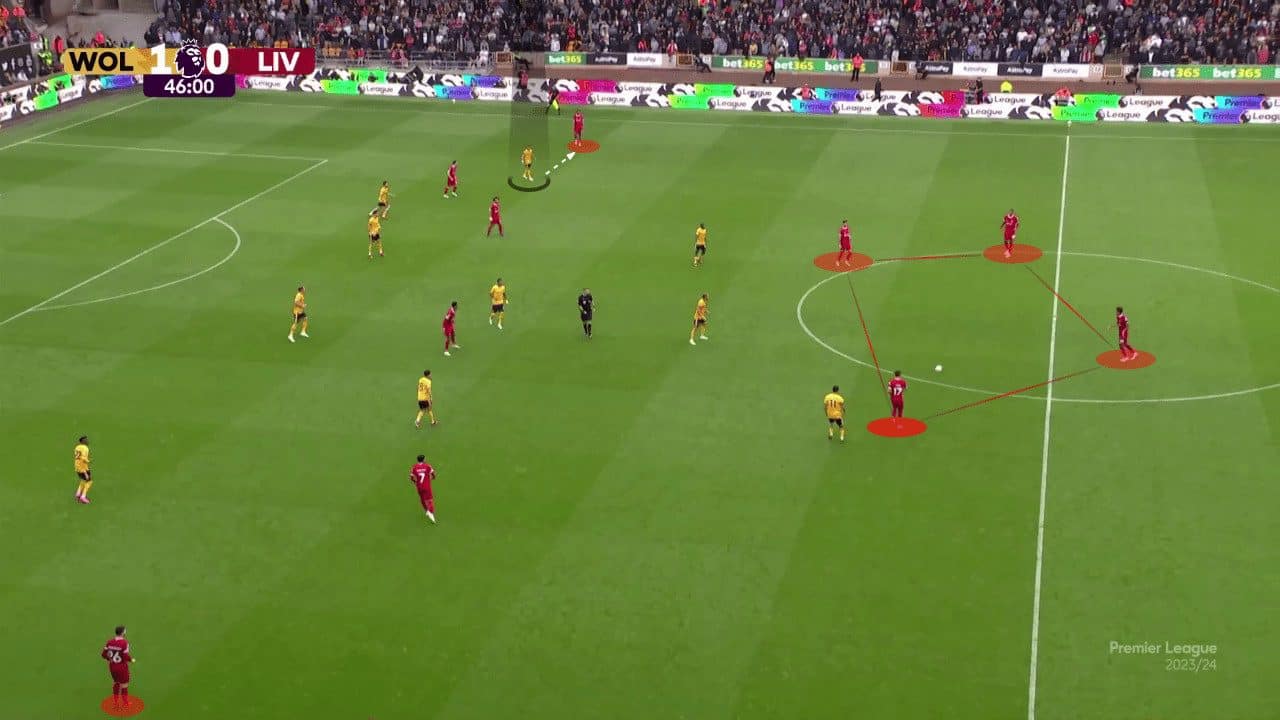
It is identically the same rest defence shape, with both Wolves wingers being dragged backwards.
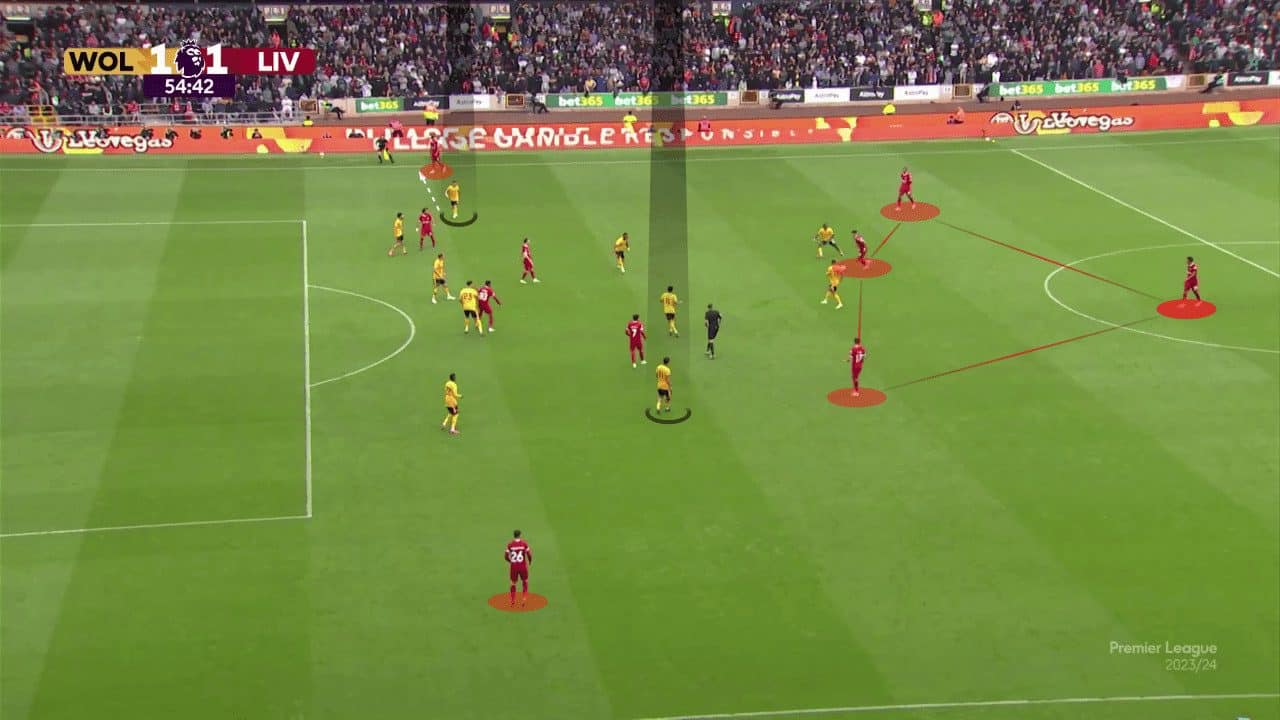
Wolves had much less goal threat from attacking transitions during the second half, thanks to Klopp’s adaptation, also scored three goals and won the game with an impressive comeback from 1–0 down to 1–3.
Conclusion
Liverpool is one of the teams that control the game and the possession and must keep a reliable rest defence structure.
Further, they don’t have defensive-minded midfielders and commonly play with Mac Allister, Szoboszlai, Curtis Jones or Ryan Gravenberch, who are more box-to-box or technical players.
Consequently, besides having a solid rest defence shape, they also compensate for the absence of the defensive midfielder through more control of the ball and flexible rotations. They have more possession of the ball and are less exposed for the transitions.





Comments